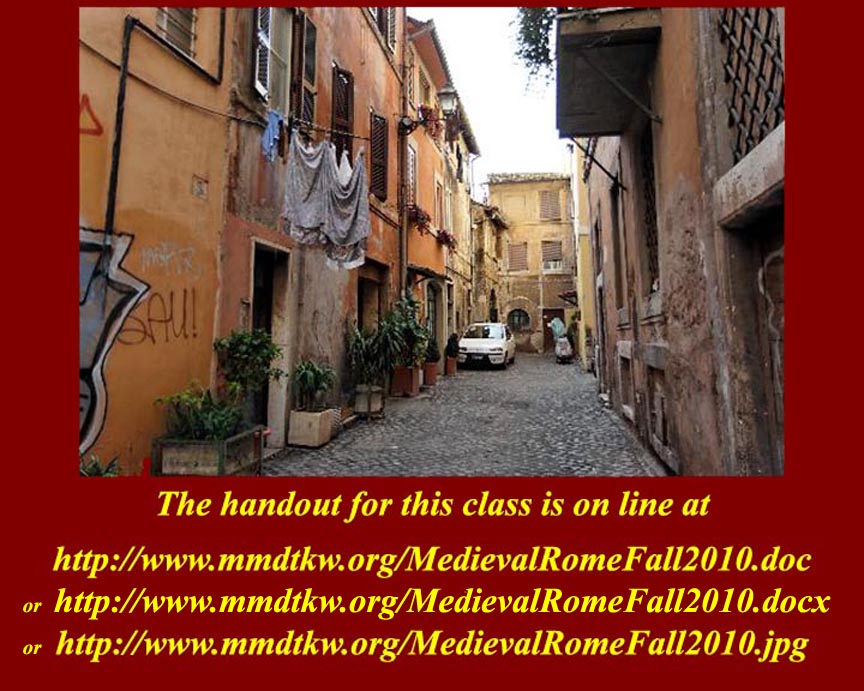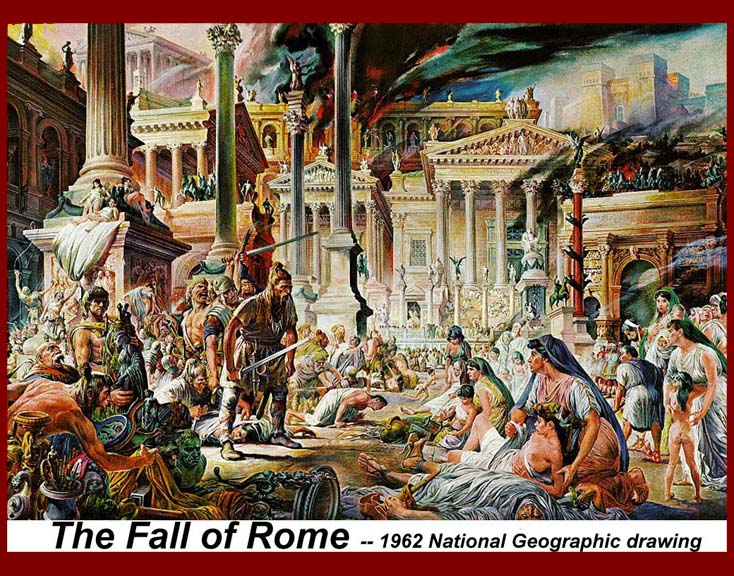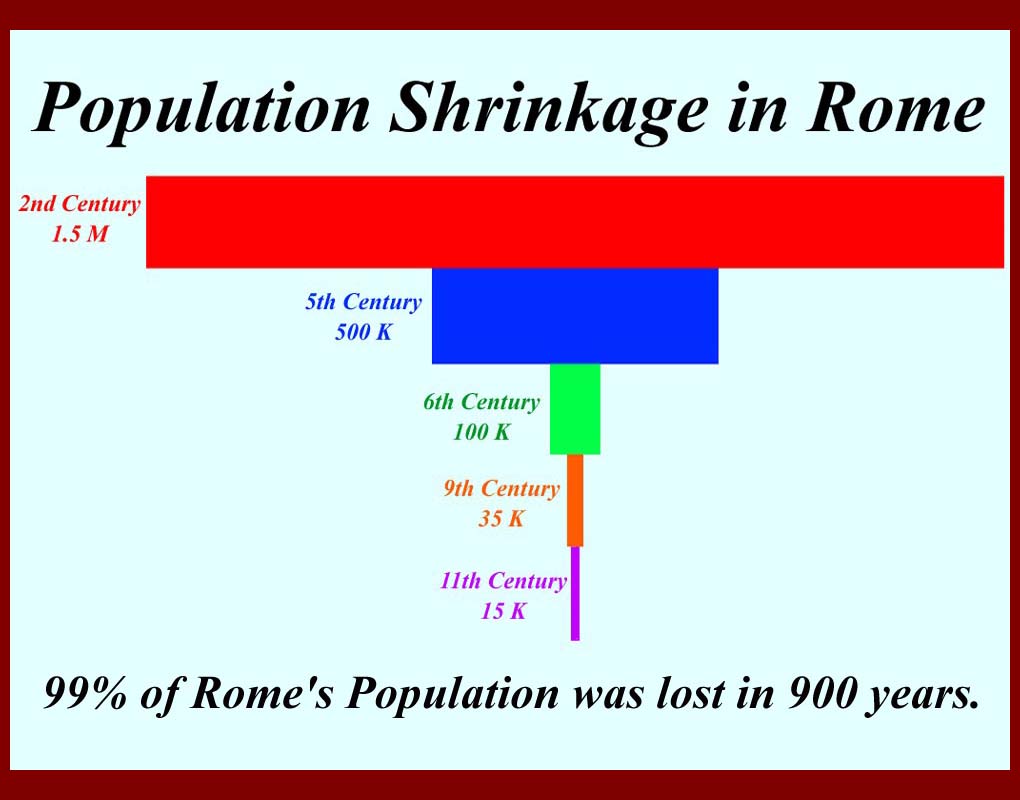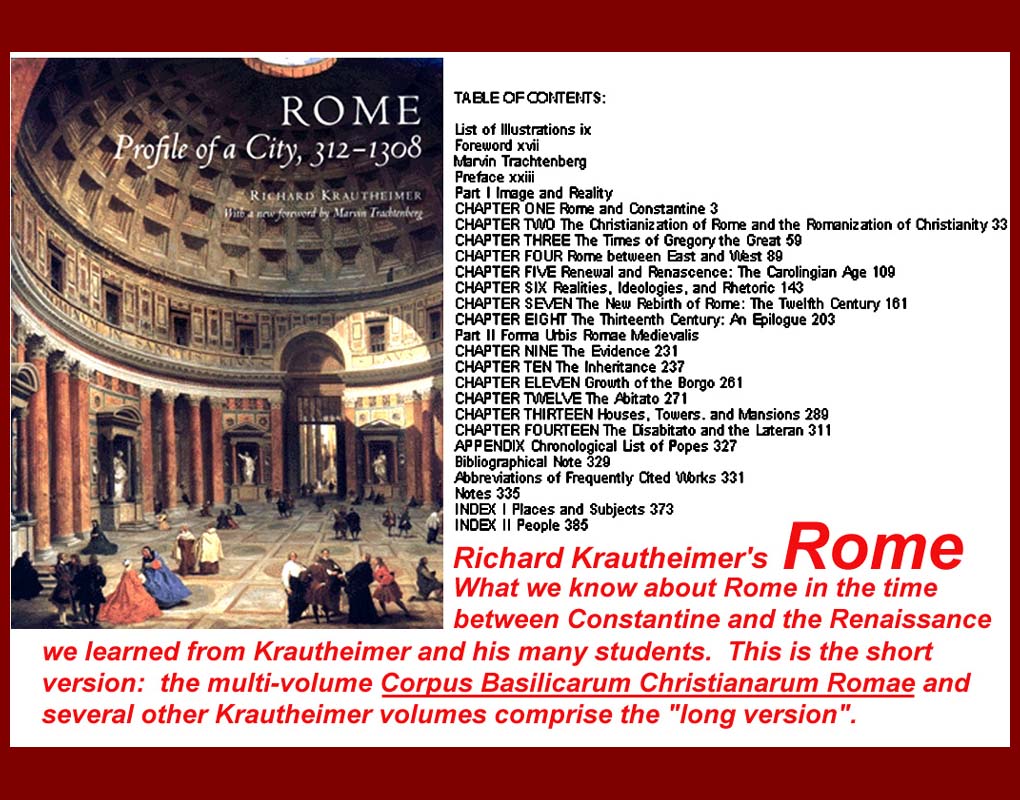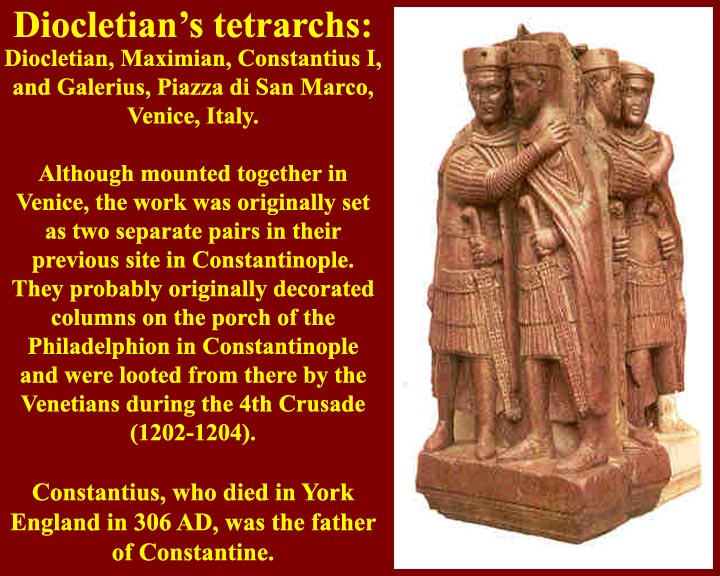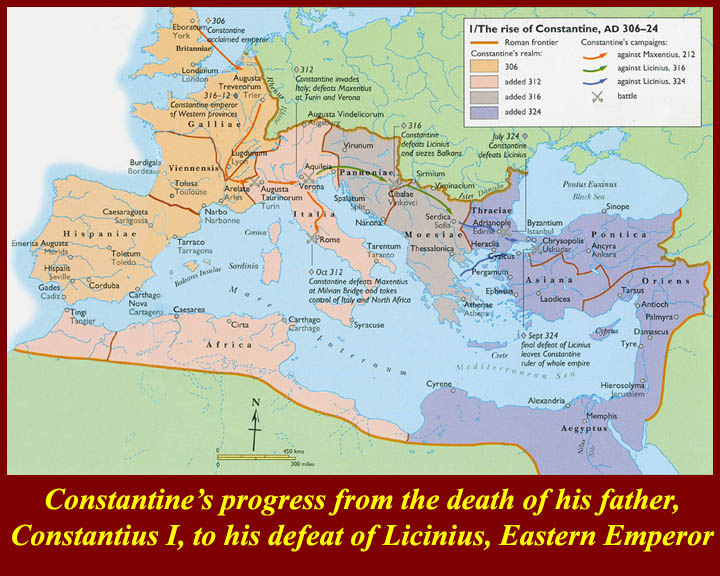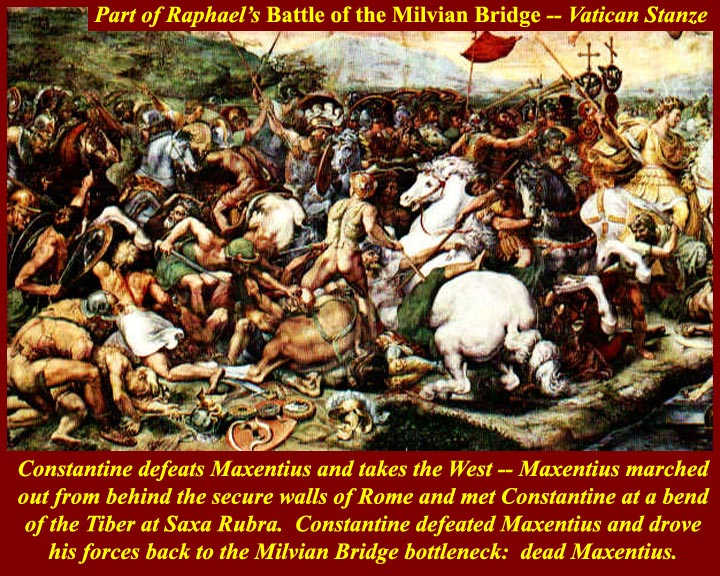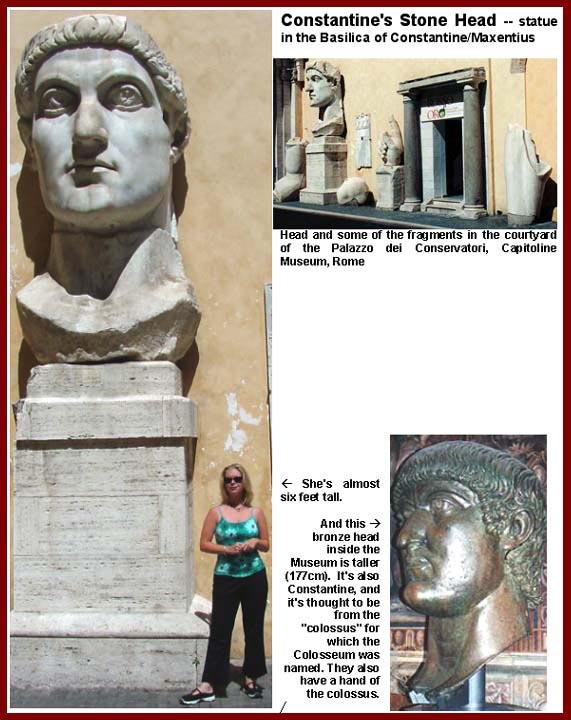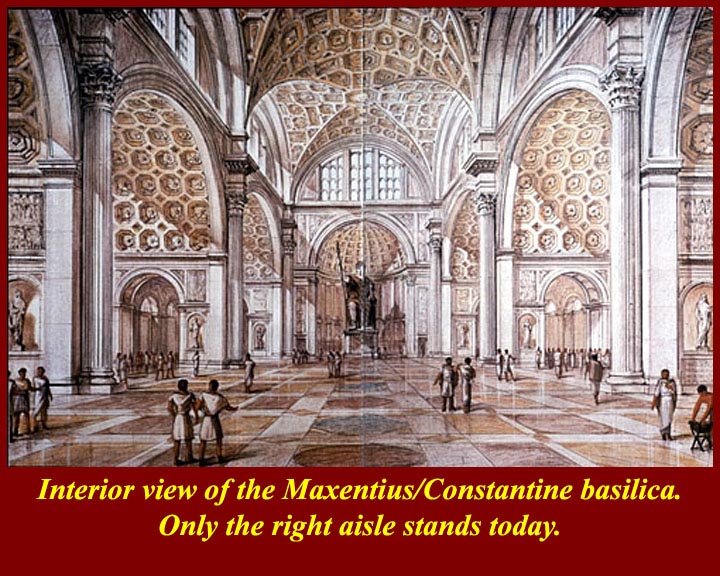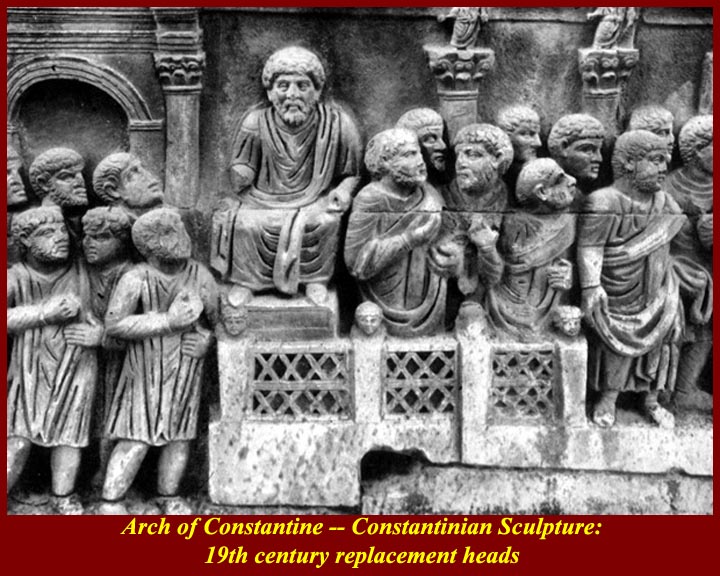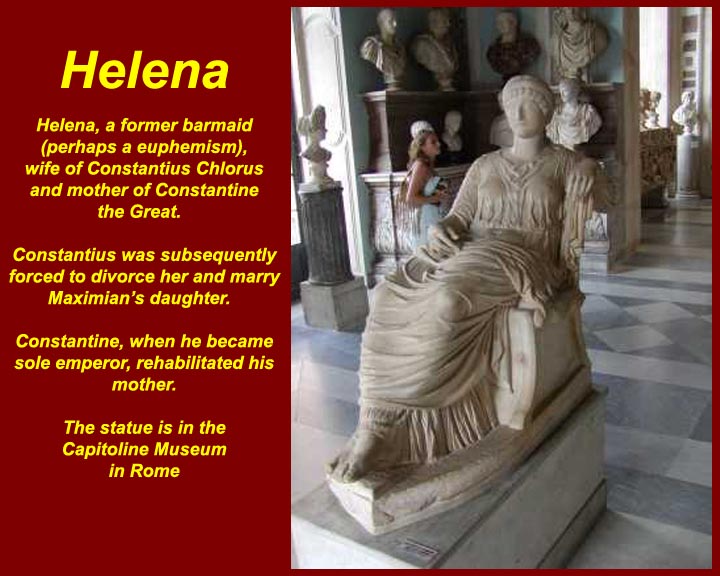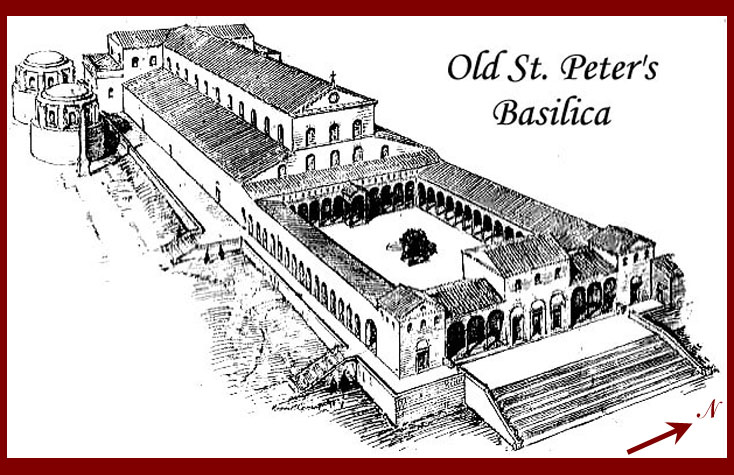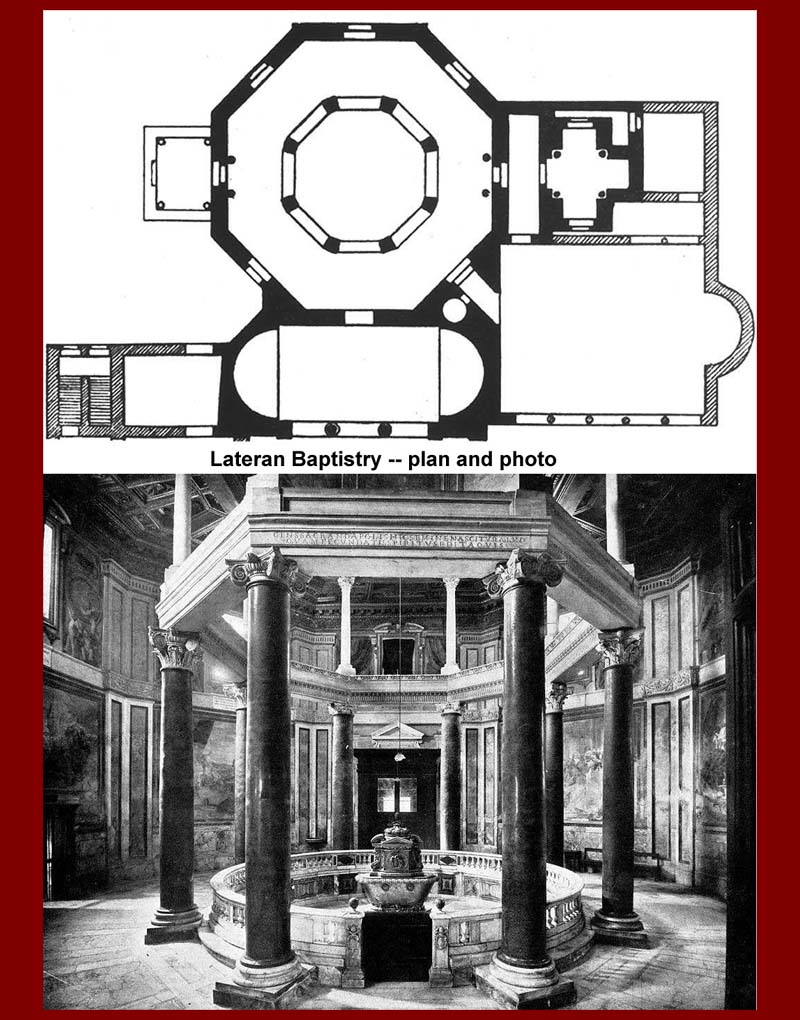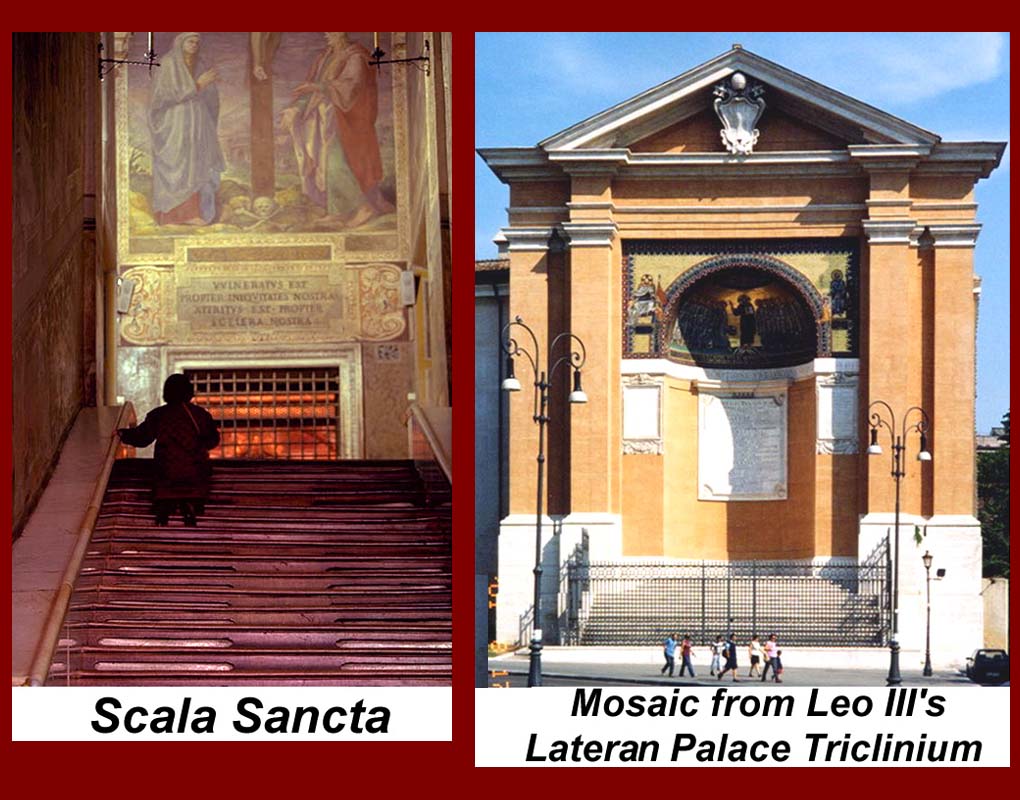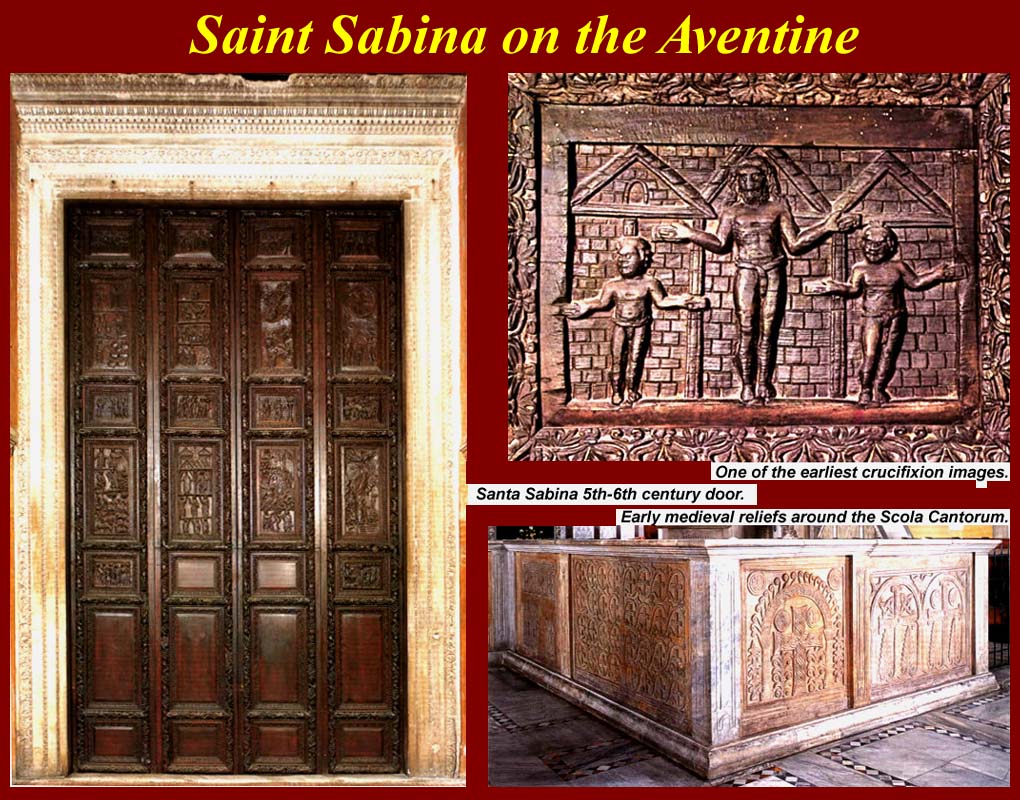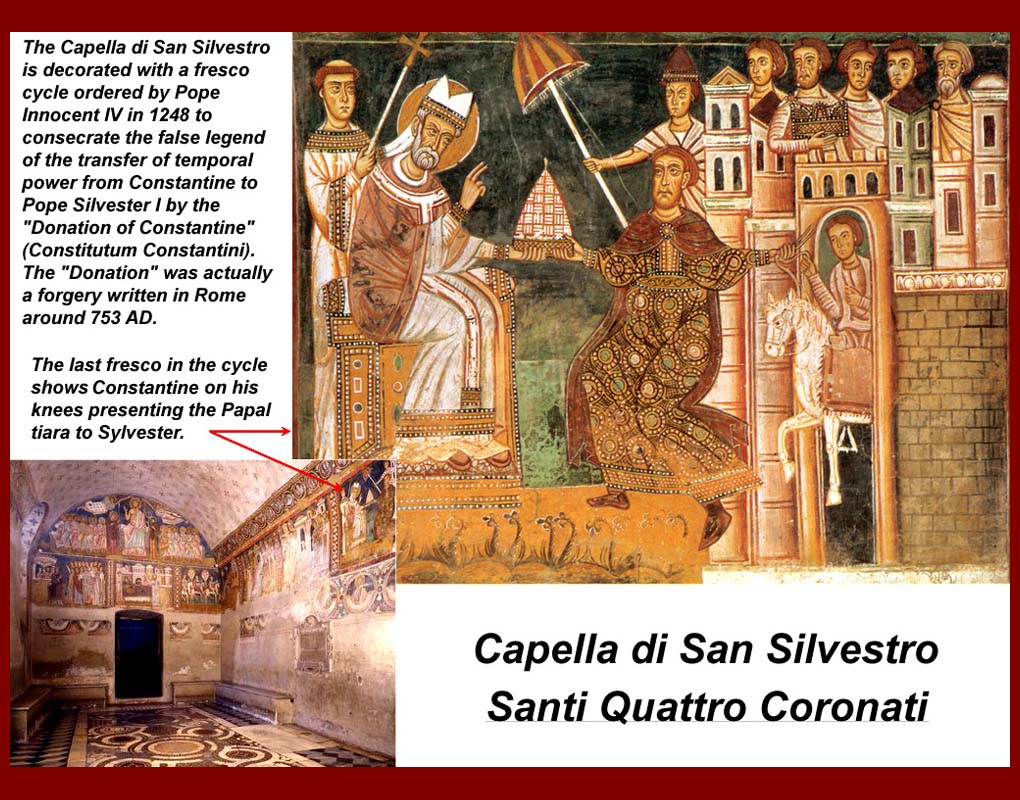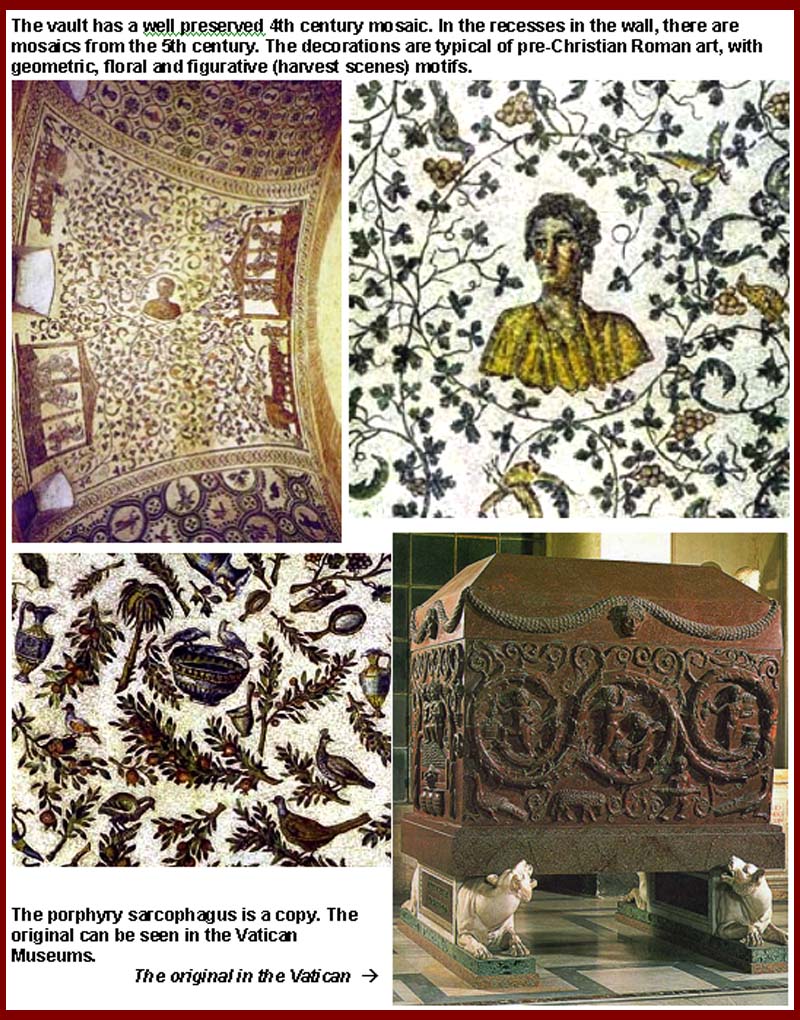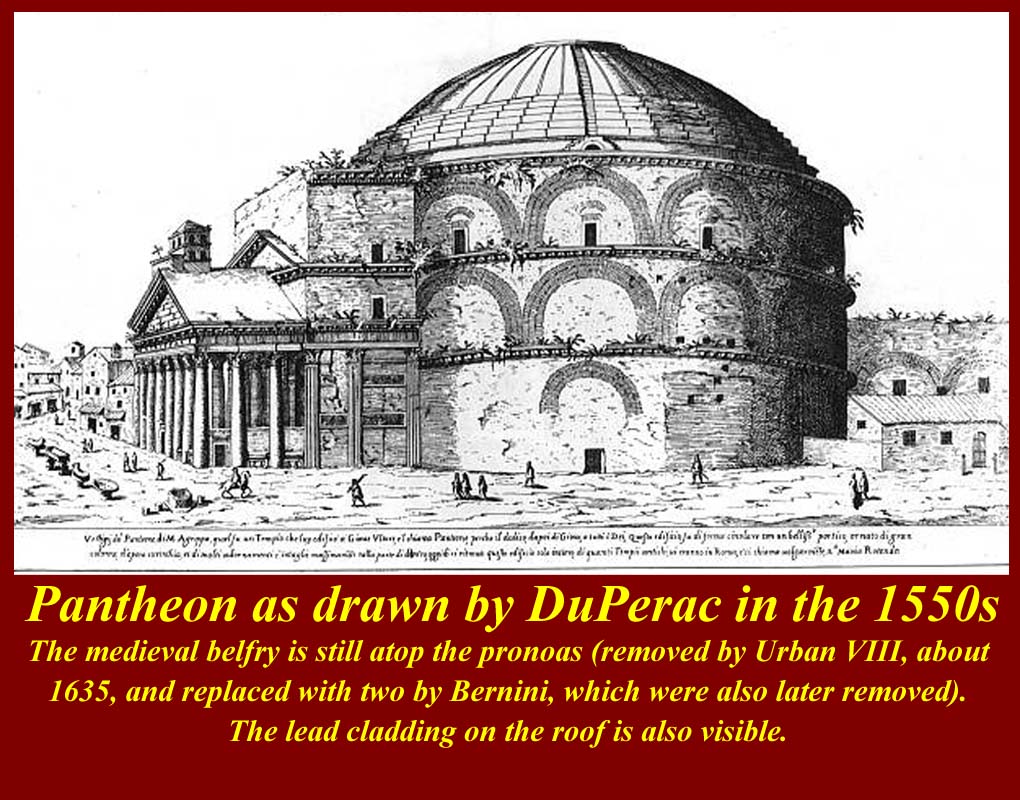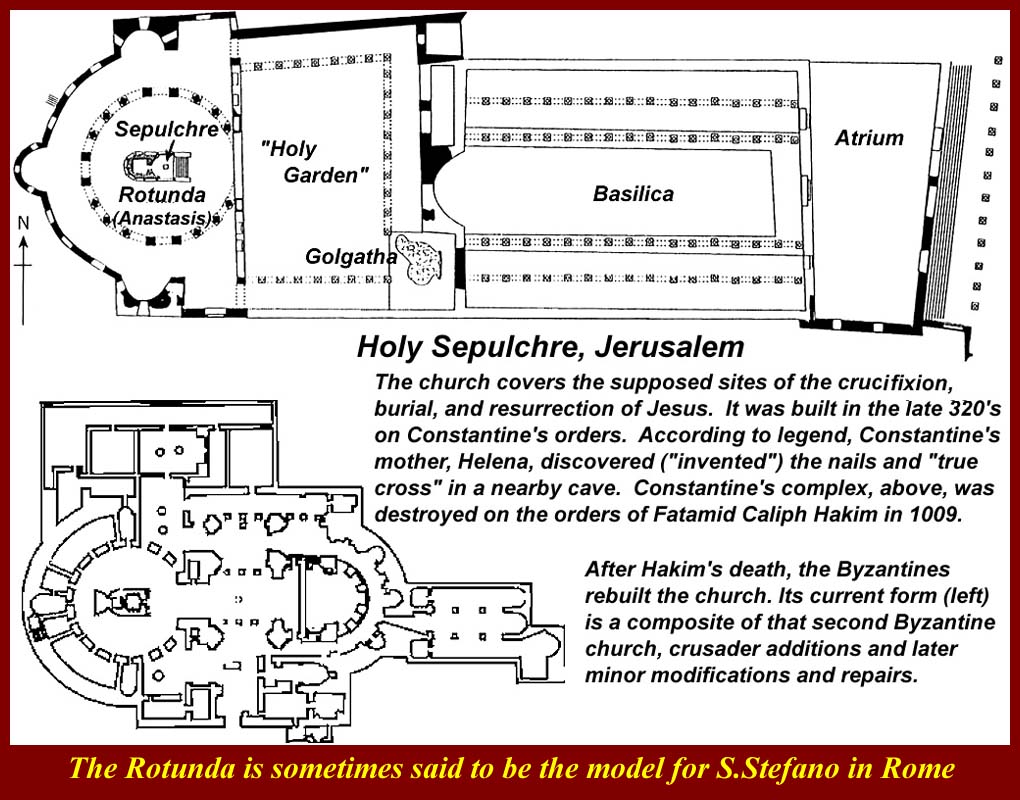Introduction:
Shrinking Rome and Constantine's Legacy
The 2010 handout for this course is available on the internet on three formats:
http://www.mmdtkw.org/MedievalRomeFall2010.doc
http://www.mmdtkw.org/MedievalRomeFall2010.docx
http://www.mmdtkw.org/MedievalRomeFall2010.pdf
Click on links or images below to go to larger pictures for Unit 1
http://www.mmdtkw.org/MedRom0101-FallNatGeog.jpg
In this 1962 image from National Geographic Magazine, we see barbarians with their Roman prisoners and spoils. The barbarians were mostly interested in loot and ransoms -- although there surely would have been some raping along with the pillaging -- or they were seeking to wring land concessions from the emperors and, later, from popes. By the time they got to Rome, many of the barbarians had been Christianized, as had been many of the Romans, although the barbarian brand of Christianity was almost always Aryan rather than Roman.
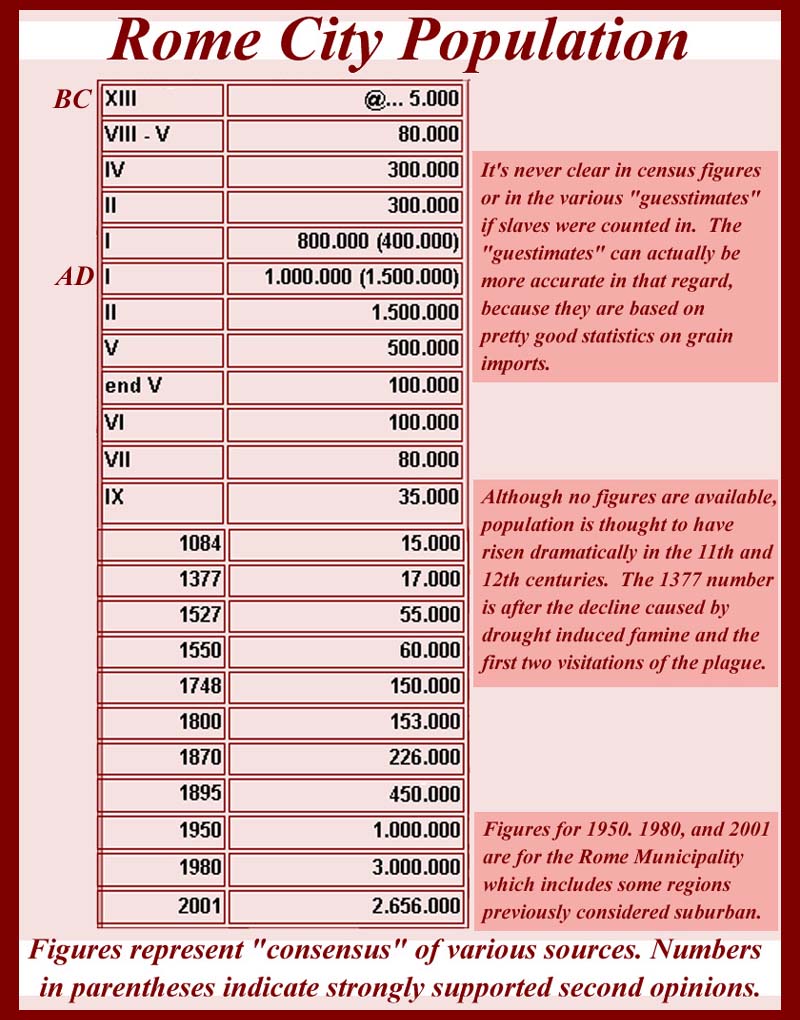
http://www.mmdtkw.org/MedRom0102-RomeCityPopul.jpg
http://www.mmdtkw.org/MedRom0103-RomePopulGraff.jpg
Numerical Chart and Graphic chart: Rome City Population decline. Rome population figures for our period of study are educated guesses at best. We know that many people left when Constantine moved the government and the bureaucracy to Constantinople in the 320s. Many also fled to to the countryside to avoid barbarian inroads and many did not return to the city after the barbarians had passed through -- particularly because barbarian damage to the aqueducts meant there was not enough water to support pre-barbarian population levels.
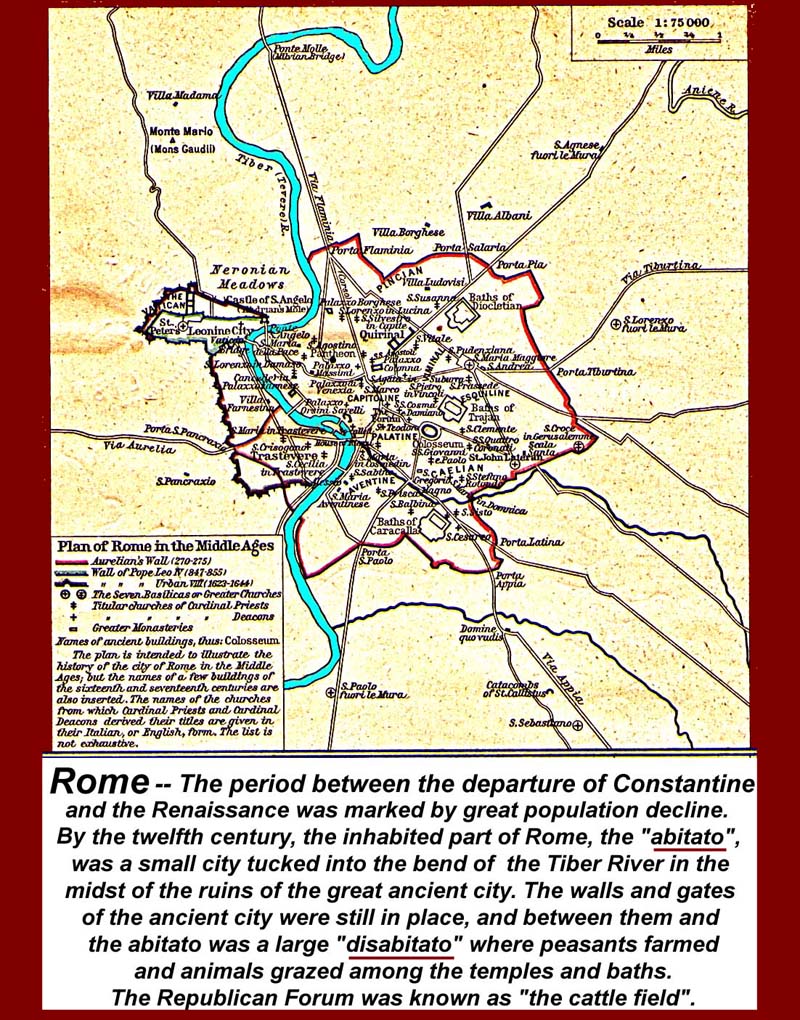
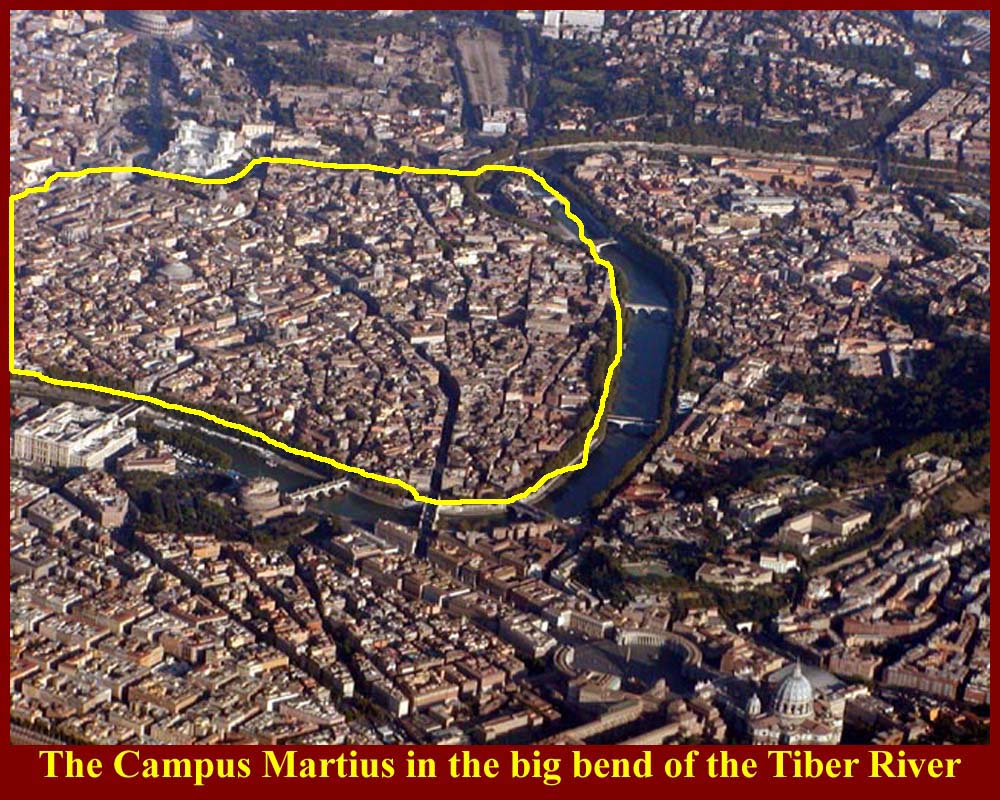
http://www.mmdtkw.org/MedRom0105-Abitato.jpg
http://www.mmdtkw.org/MedRom0105a-CampMartAer.jpg
http://www.mmdtkw.org/MedRom0106-RomeMap.jpg
Damage to the aqueducts also meant that the higher sections of the city had no reliable water supply; by the end of Rome's Medieval period, the city's population was mostly concentrated in the lower areas on both sides of the Tiber and especially in the Campo Marzio.
http://www.mmdtkw.org/MedRom0104-KrautheimerAd.jpg
The definitive studies of medieval Rome were Krautheimer's Corpus Basilicarum Christianorum Romae and several others of his books. The short version, shown here, is available from online bookstores.
-----------------------------------------------------
The size of the Roman Empire from 1 AD through 1500 AD at 100 year intervals:
http://www.mmdtkw.org/MedRom0107-EmpireMap01AD.jpg
http://www.mmdtkw.org/MedRom0108-EmpireMap100AD.jpg
http://www.mmdtkw.org/MedRom0109-EmpireMap200AD.jpg
http://www.mmdtkw.org/MedRom0110-EmpireMap300AD.jpg
http://www.mmdtkw.org/MedRom0111-EmpireMap400AD.jpg
http://www.mmdtkw.org/MedRom0112-EmpireMap500AD.jpg
http://www.mmdtkw.org/MedRom0113-EmpireMap600AD.jpg
http://www.mmdtkw.org/MedRom0114-EmpireMap700AD.jpg
http://www.mmdtkw.org/MedRom0115-EmpireMap800AD.jpg
http://www.mmdtkw.org/MedRom0116-EmpireMap900AD.jpg
http://www.mmdtkw.org/MedRom0117-EmpireMap1000AD.jpg
http://www.mmdtkw.org/MedRom0118-EmpireMap1100AD.jpg
http://www.mmdtkw.org/MedRom0119-EmpireMap1200AD.jpg
http://www.mmdtkw.org/MedRom0120-EmpireMap1300AD.jpg
http://www.mmdtkw.org/MedRom0121-EmpireMap1400AD.jpg
http://www.mmdtkw.org/MedRom0122-EmpireMap1500AD.jpg
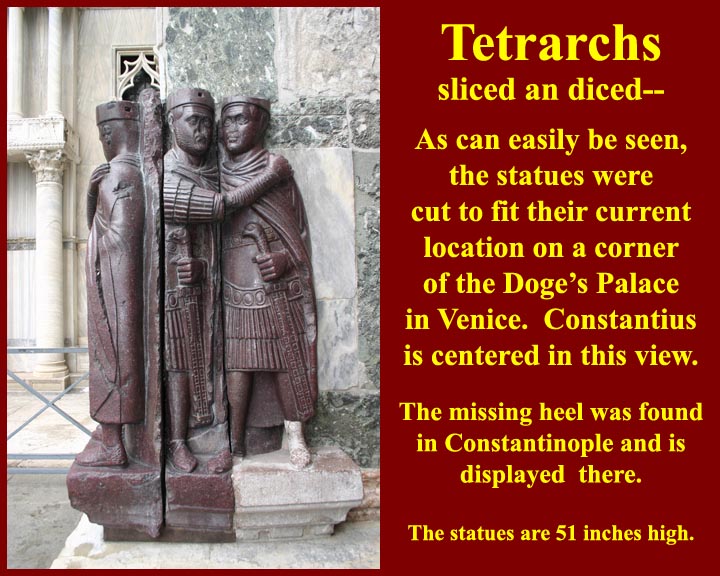
http://www.mmdtkw.org/MedRom0122a-Tetrarchs.jpg
http://www.mmdtkw.org/MedRom0122aaTetrarchStatues.jpg
Diocletian realized that the Empire had grown to the point that if could no longer be controlled by one man in one place. He divided the Empire among two Augusti and two Caesars and established each in his own headquarters. Eventually, Diocletian retired and left the Empire in other hands. Almost immediately, the four rulers that he left behind began to fight for supremacy.
http://www.mmdtkw.org/MedRom0122ab-Constantine's Rise.jpg
The ultimate winner of the power struggle was, of course, Constantine. He Succeeded his father in the northwest, defeated Maxentius for control of Rome, and then rolled up the two eastern quarters.
http://www.mmdtkw.org/MedRom0122ac-Raphael-ConstantineMilvianBridge.jpg
The decisive Battle of the Milvian Bridge, in which Constantine defeated Maxentius, was on 28 October 312 AD. A newer iteration of the bridge crosses the Tiber north of Rome. The real victory was a few miles north of there at a place still called Saxa Rubra ("Red Rock") -- what happened at the Milvian Bridge was that the already routed army of Maxentius was bottle-necked and slaughtered. A body identified as that of Maxentius was pulled from the river near the bridge the morning after the battle. Military strategists still argue about why Maxentius left the walled city of Rome to fight Constantine at Saxa Rubra.
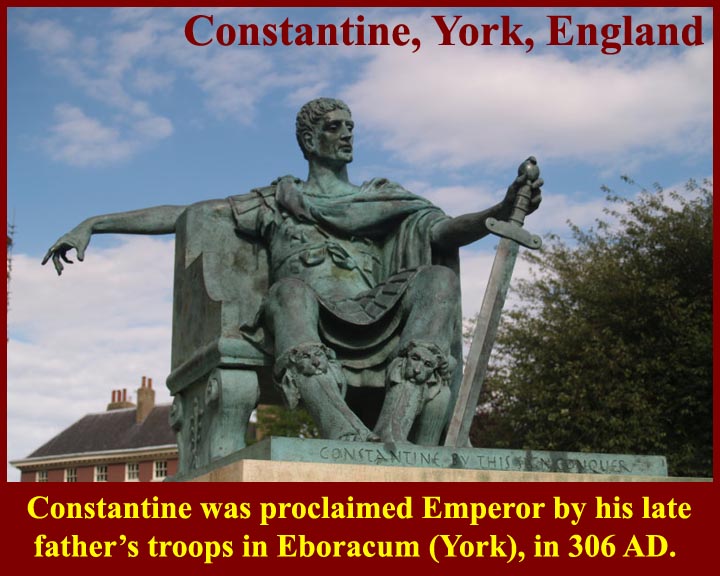

http://www.mmdtkw.org/Medrom0122b-ConstantineYork.jpg
http://www.mmdtkw.org/MedRom0122ba-Constantine.jpg
http://www.mmdtkw.org/MedRom0122bb-ConstantineHead.jpg
York England memorializes the fact that Constantine was first proclaimed "Imperator" there. In Rome, massive statues were raised in Constantine's honor. A new bronze head -- Constantine's -- was attached to the colossal statue of the sun god near the Colosseum that had first been erected by Nero. An even bigger stone statue was set up in the huge basilica that had been started by Maxentius and finished by Constantine.
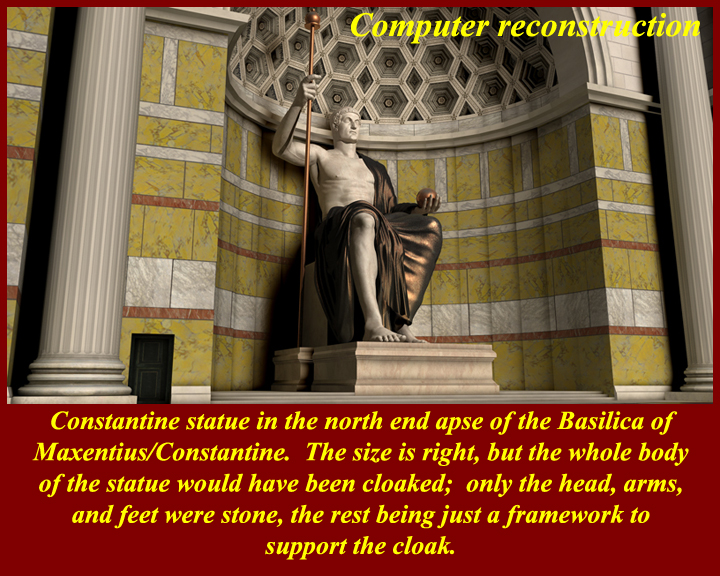
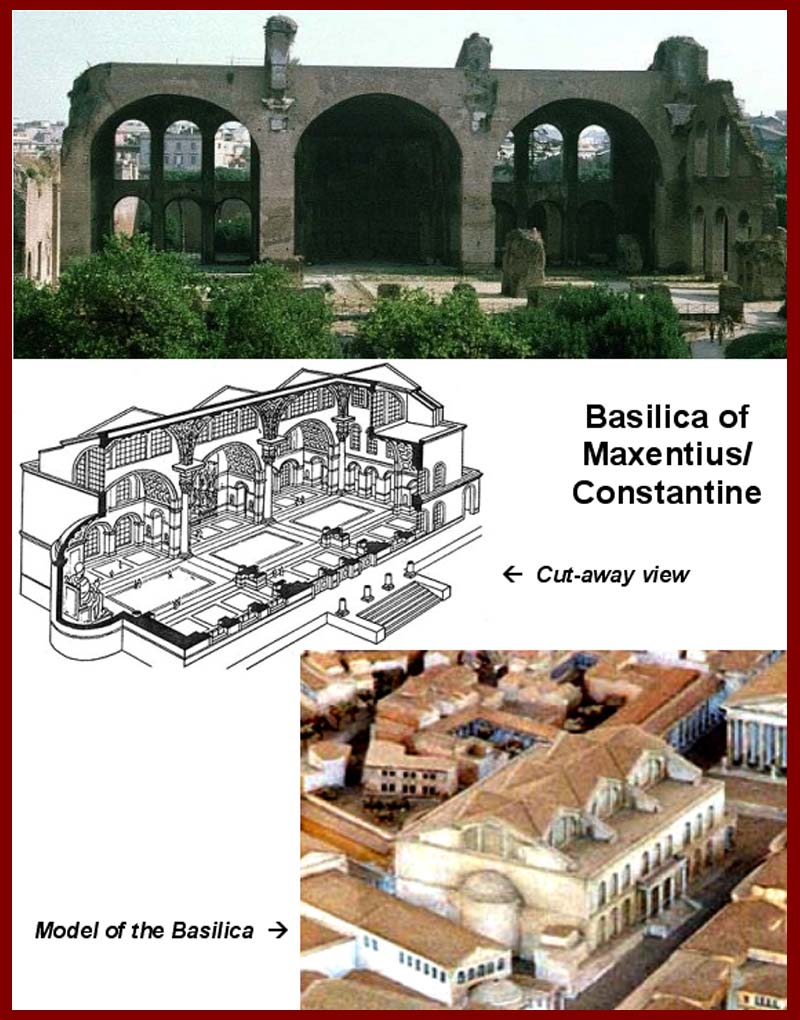
http://www.mmdtkw.org/MedRom0122bc-Constantine BasilicaMax.jpg
http://www.mmdtkw.org/MedRom0123-BasilicaMaxenti.jpg
http://www.mmdtkw.org/MedRom0123a-BasilicaMaxInteriorReconst.jpg
But the stone statue in the basilica was an acrolith (the head, hands and feet were of marble, while the rest was of other materials). The remains of the statue were found in 1486 in the apse of the basilica. The basilica was the largest ever built in Rome, and it was the last non-Christian structure built in the Roman forum. Everything after this was churches, and they were invariably built into or on the remains of ancient Roman structures.
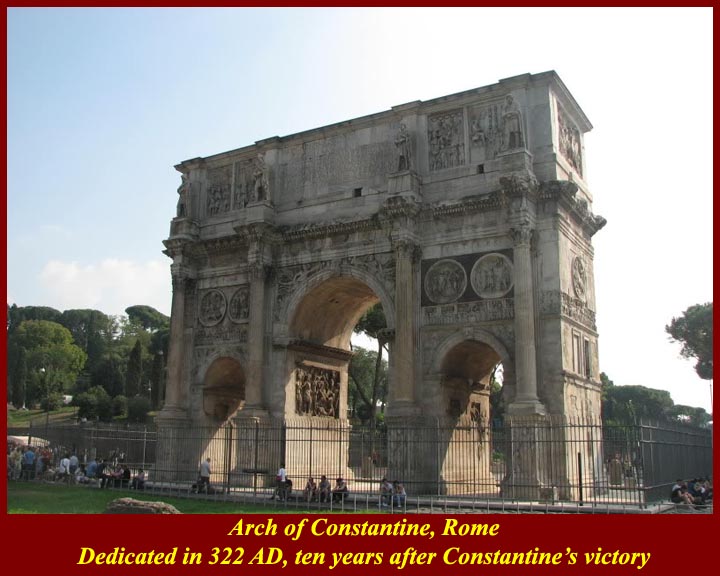
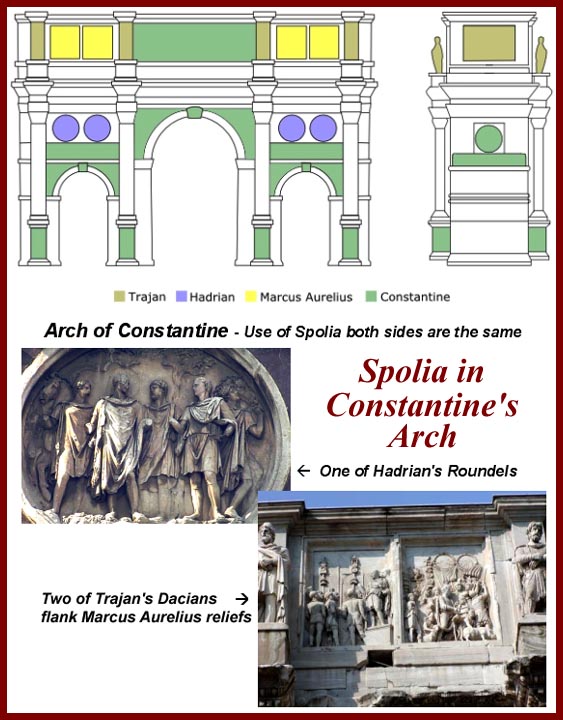

http://www.mmdtkw.org/MedRom0123aa-ArchConstantine.jpg
http://www.mmdtkw.org/MedRom0123ab-ArchConstantineSpolia.jpg
http://www.mmdtkw.org/MedRom0123ac-ArchConstsantineComparison.jpg
http://www.mmdtkw.org/MedRom0123ad-ArchConstantineConstantinian.jpg
Arches along the routes through Rome of the "triumphs" of Roman generals were rather flimsy wooden structures that were later replaced with stone monuments, some of which we can still see today. The huge stone Arch of Constantine near the Colosseum was in place by 322 AD when he returned to Rome from his new eastern capital for the tenth anniversary of his victory over Maxentius. Almost all of the artwork on the Arch of Constantine is "spolia", i.e., pieces that the builders looted from the monuments of earlier emperors. In some cases, old pieces were modified by resculpting heads to resemble Constantine. The parts of the Arch that were original in Constantine's time show that the skills of available artists were much degraded from those of artists of earlier times. What we see today is the result of a 19th century renovation during which stolen or weathered heads were replaced. It's the thought that counts.
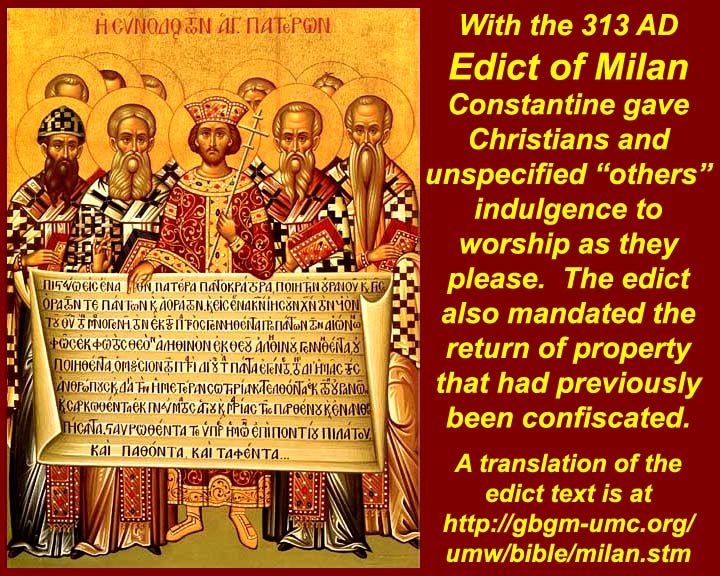
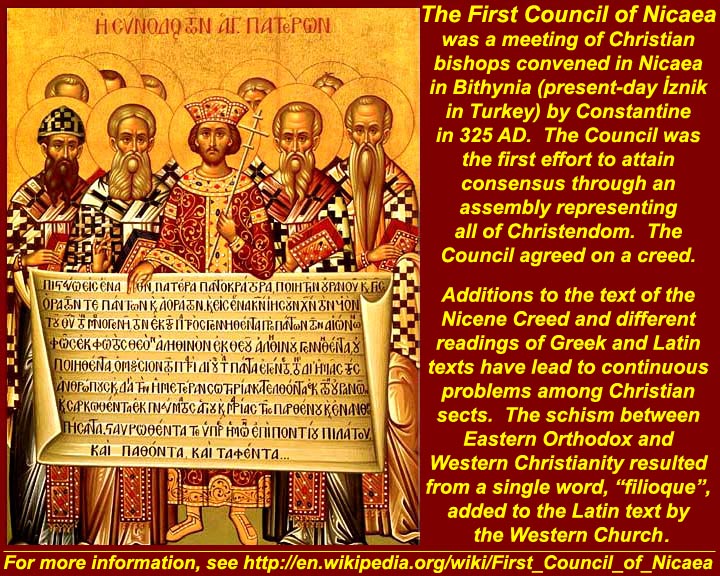
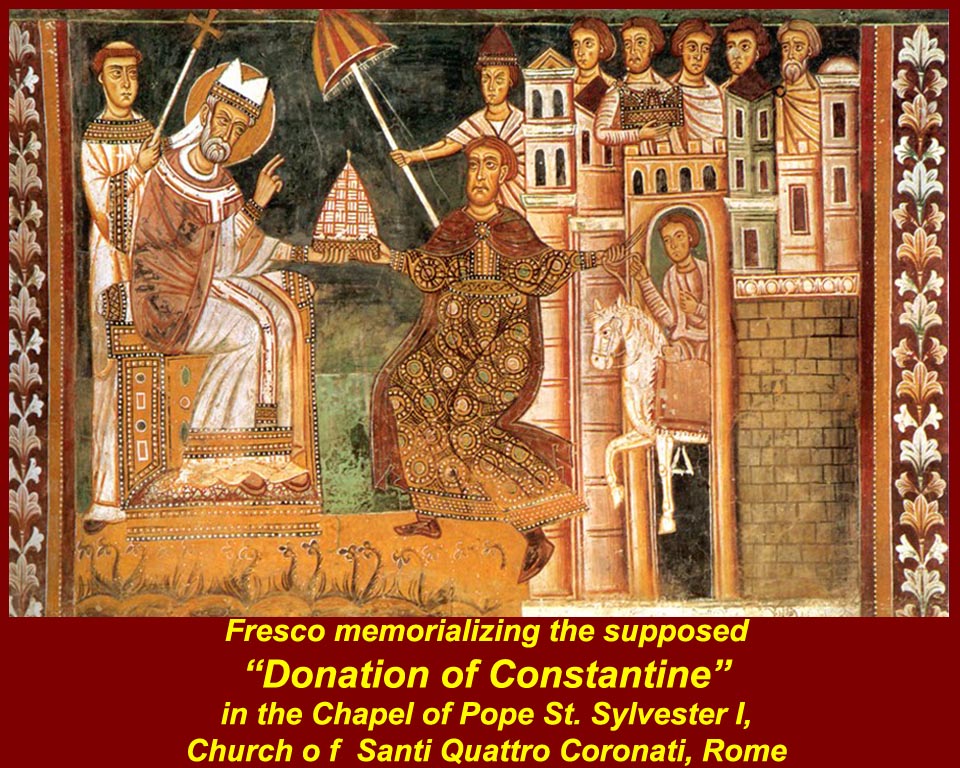
http://www.mmdtkw.org/MedRom0123ae-313AD-MilanEdict.jpg
http://www.mmdtkw.org/MedRom0123af-325AD-NiceaCouncil.jpg
http://www.mmdtkw.org/MedRom0123ag-SylvesterDonationConstantine.jpg
http://www.mmdtkw.org/MedRom0123b-Helena.jpg
Constantine's support for Christianity may have been opportunistic or it may have been faith based, but either way it was definitive for Western history. His military conquest at Saxa Rubra "under the sign of Christ" meant that Christianity was a viable alternative to old Roman paganism and that it had an advantage over other Mystery Religions like Mithraism, Isis worship, the Elysian mysteries (Demeter/Persephone worship), and the Dionysian mysteries.
Constantine issued the Edict of Milan (where he had is headquarters after conquering Rome) in 313 AD, and he organized the 325 AD Council of Nicaea, which was supposed to stop intra-Christian squabbles by producing the Nicene Creed. According to a forgery cooked up shortly before or after 800 AD, he also passed secular authority over Rome from the Emperors to the Popes (in the person of Sylvester I. In actual fact, the Empire simply abandoned Rome and headed east to Constantinople leaving the pieces of Rome gradually to be picked up by the Church. There is a wealth of Christian mythology surrounding the person of Constantine's mother, Helena, but little is really known about her. Constantine's father, Constantius, picked he up in a bar in the east when he was a subaltern in the Roman army -- she was either a barmaid or a hooker or both -- and married her. But Constantius rose through the ranks and eventually had to send Helena away and get an appropriate wife. In the meantime, Constantine was born. After becoming Emperor, Constantine rehabilitated his mother, and she traveled around the Middle East finding the "true cross" and Christian Holy sites. She is also said to have provided the impetus for the founding of Rome's great pilgrimage churches.
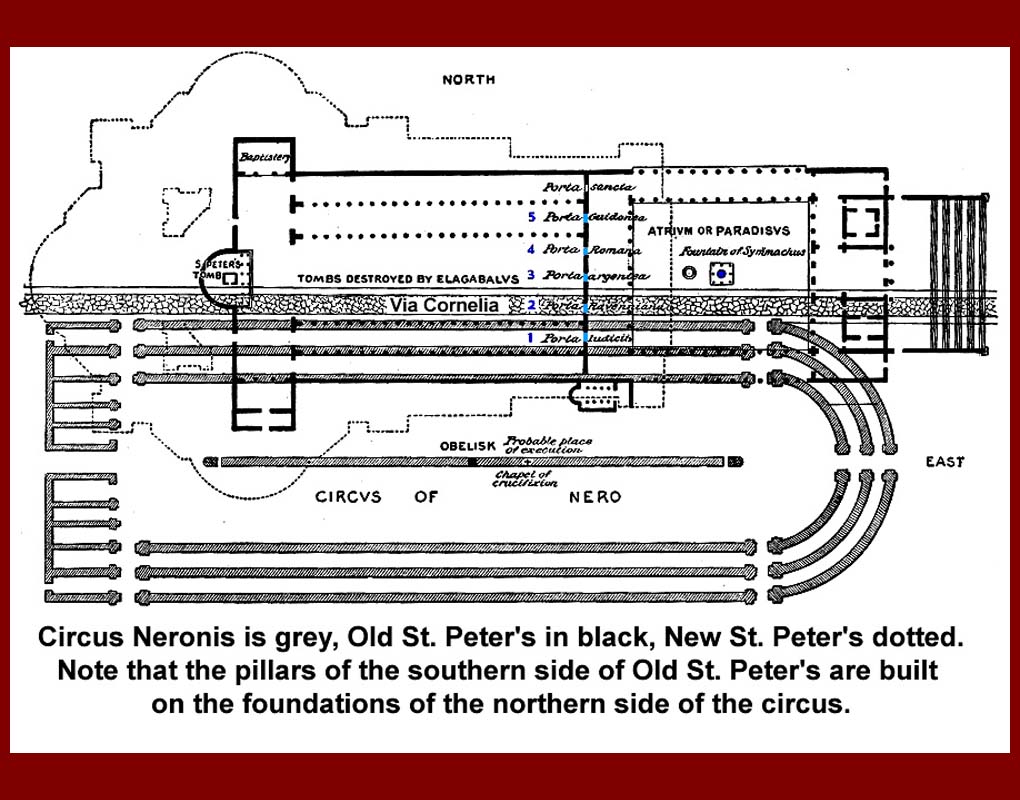
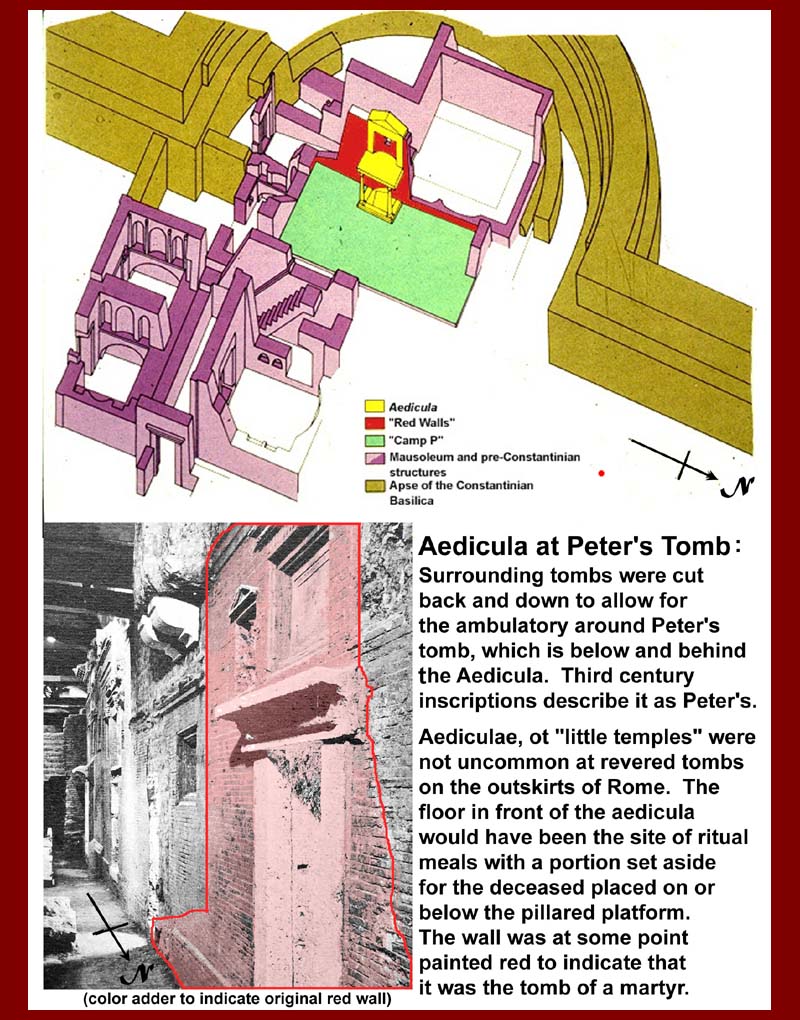
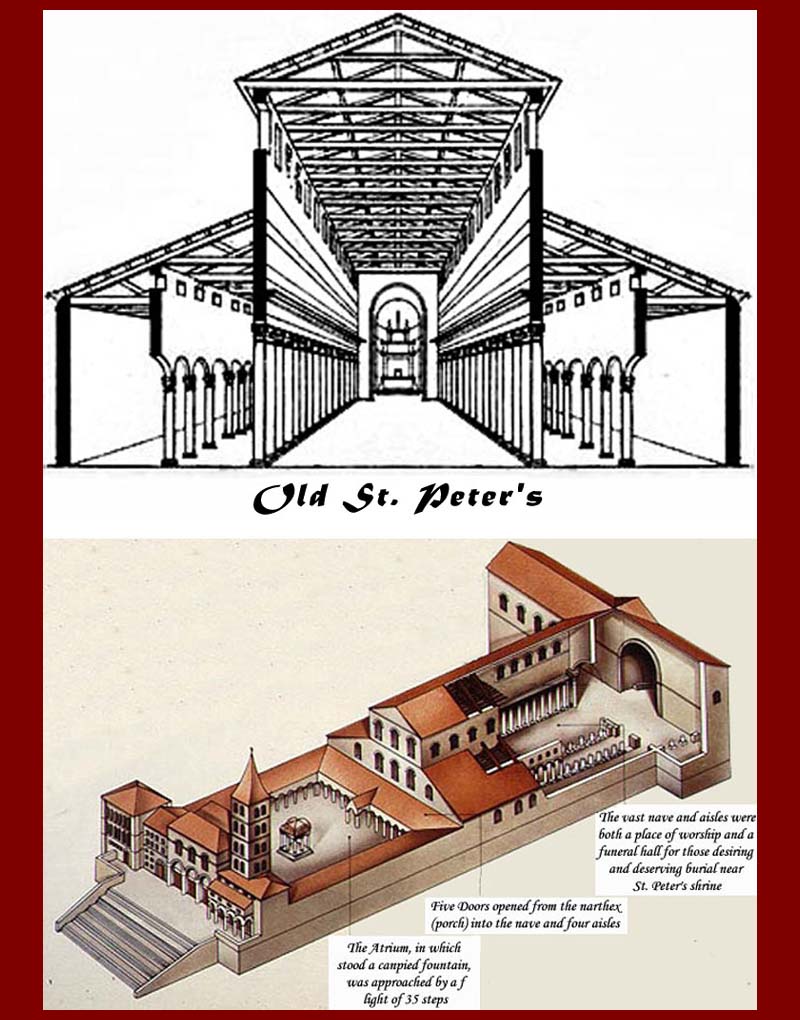
http://www.mmdtkw.org/MedRom0124-StPeLancianiPlan.jpg
http://www.mmdtkw.org/MedRom0125-StPeAedicula.jpg
http://www.mmdtkw.org/MedRom0126-StPeReconst.jpg
http://www.mmdtkw.org/MedRom0126A-StPet-Iso.jpg
The most important church in Rome today is probably that of St. Peter in the Vatican (although it was not the most important initially). St. Peter's -- actually Constantine's "old" Sr. Peter's -- was a martyrion, a church built on the site of a martyr's tomb. Peter, according to Christian tradition, was killed at the base of the obelisk that marked the center of the spina of the Circus of Nero on the Vatican Hill. Next to the Circus, which was actually initiated by Caligula, was a road, and along the road was a cemetery, excavation of which has revealed a shrine (aedicula) said to mark the burial place of Peter. The wooden basilica was built over the aedicula.
For more images, see http://www.saintpetersbasilica.org/images.htm.
Old St. Peter's was, of course, replaced by the current church, "New" St. Peter's, during the renaissance. The old basilica had an unstable -- or rather unequal -- foundation. The south basilica wall was built on the base of the north grandstand of the Nero circus, but the north wall of the basilica was built on semi-plastic clay and on landfill over the old cemetery. The inequality of the foundations on the two sides had caused the north wall to sag outward, and it couldn't be repaired.
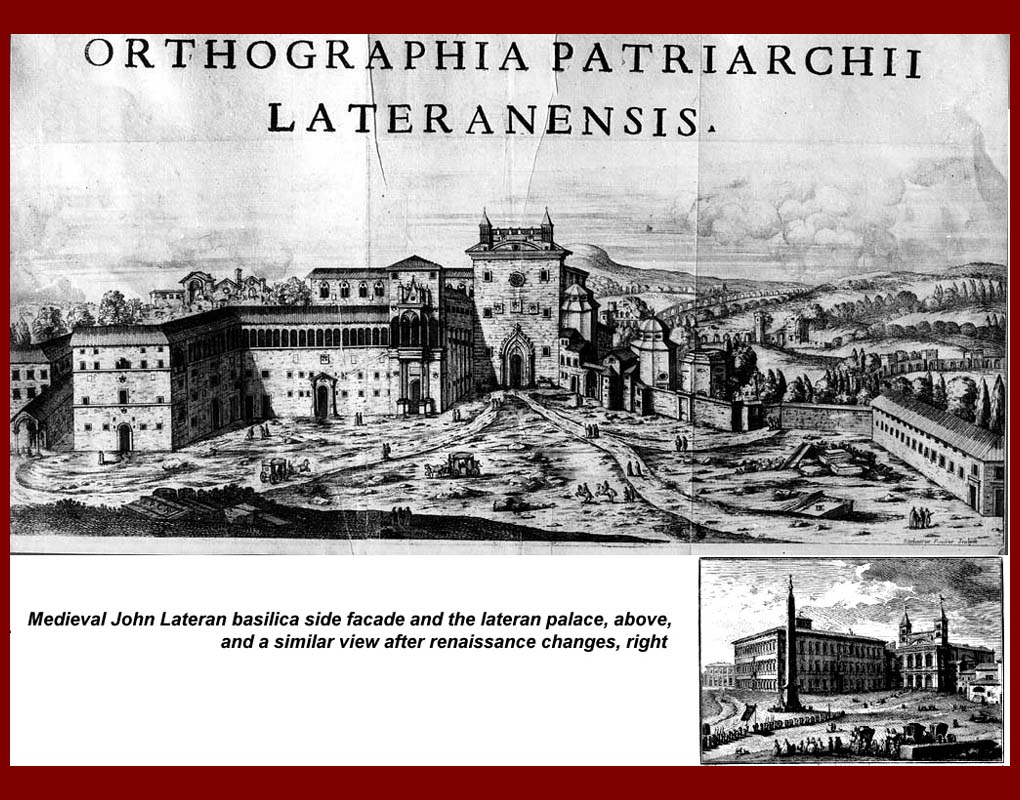
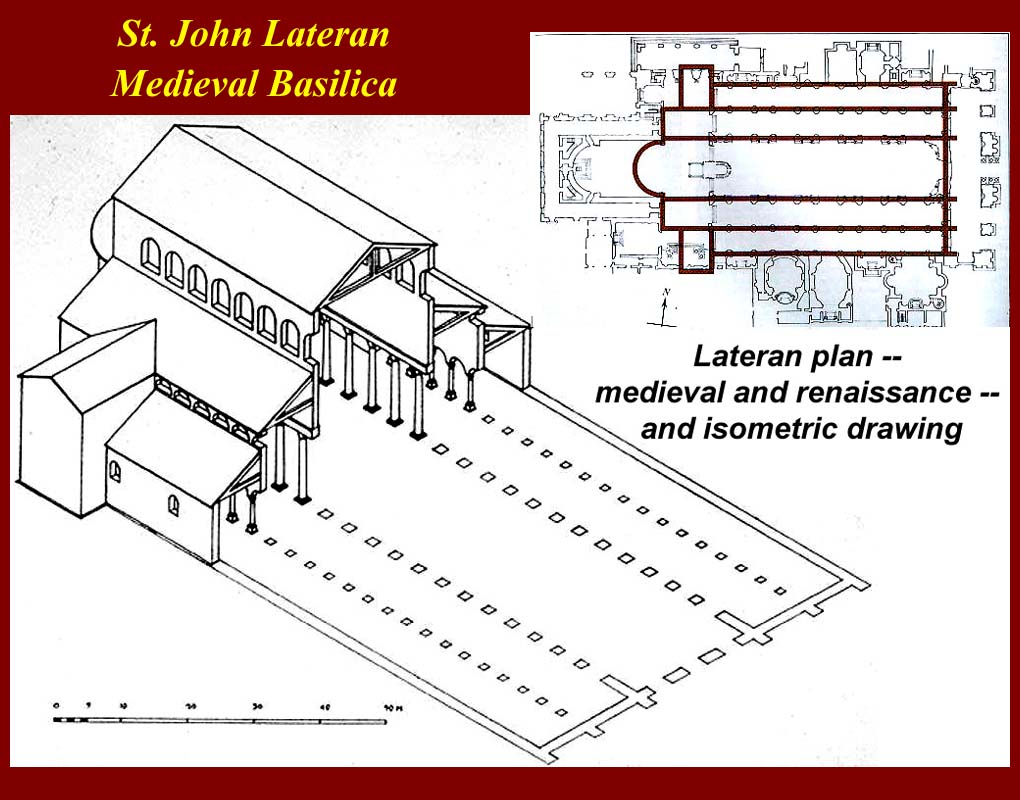
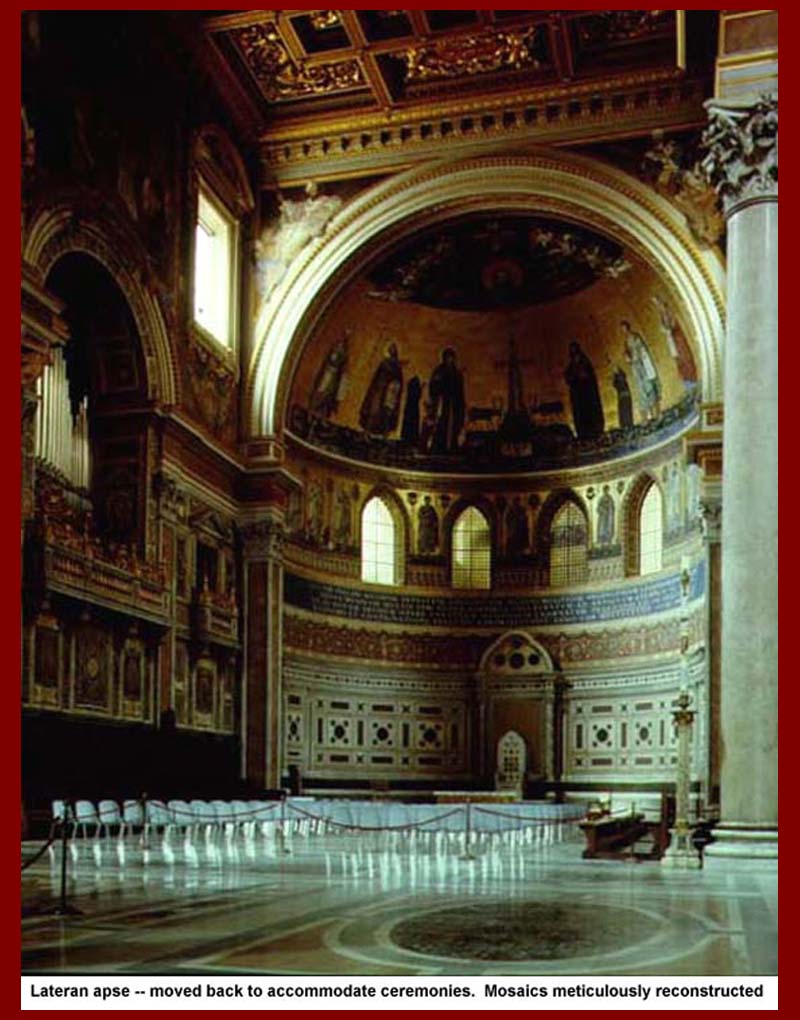
http://www.mmdtkw.org/MedRom0127-MedievalLateran.jpg
http://www.mmdtkw.org/MedRom0128-LateranPlanIsom.jpg
http://www.mmdtkw.org/MedRom0129-LateranApseMosa.jpeg
http://www.mmdtkw.org/MedRom0130-LateranBaptistry.jpg
St. John Lateran basilica predated the St. Peter martyrion by a few years, and because it was built on a more stable foundation, it was expanded and enhanced during the renaissance rather than being demolished and rebuilt. For many years, St. John Lateran was the seat of the Popes. Only later, when the cult of Peter grew, did his church on the other side of town achieve primacy. The baptistery, which, like other medieval baptisteries, is outside of the basilica, was built on the site of a pre-Christian bath-house, which may itself have been built over a "sacred spring". For more on the Lateran basilica, see http://www.sacred-destinations.com/italy/rome-san-giovanni-laterano. For more on the baptistery, see http://www.sacred-destinations.com/italy/rome-lateran-baptistery.
http://www.mmdtkw.org/MedRom0131-ScalaSanctMosaic.jpg
Within sight of the St. John Lateran basilica is the church of the Scala Sancta, which houses remnants of the original Lateran palace. The Scala Sancta is, according to the Christian tradition, the stairway that led up to the praetorium of Pontius Pilate in Jerusalem, which Jesus Christ stood on during his Passion on his way to trial. The stairs were, reputedly, brought to Rome by St. Helena in the 4th Century (in some versions of the story she reputedly flew them to Rome miraculously). For centuries, the Scala Santa has attracted Christian pilgrims who wished to honor the Passion of Jesus. Pilgrims are supposed to climb the Scala Sancta on their knees, but there is an adjacent "tourist" stairway for non-Pilgrims.
The Scala Sancta consists of twenty-eight white marble steps, now encased by wooden steps to minimize wear, located in a building which incorporates part of the old Lateran Palace, located opposite the Basilica of Saint John Lateran. They are located next to a church which was built on ground brought from Mount Calvary. The stairs lead to the Sancta Sanctorum (English: Holy of Holies), the personal chapel of the early Popes in the Lateran palace, known as the chapel of St. Lawrence. On an outer wall of the Scala Sancta structure is a large reconstructed mosaic from an apse of the Lateran Palace triclinium of Leo III (the pope during the visit of Charlemagne in 800 AD).
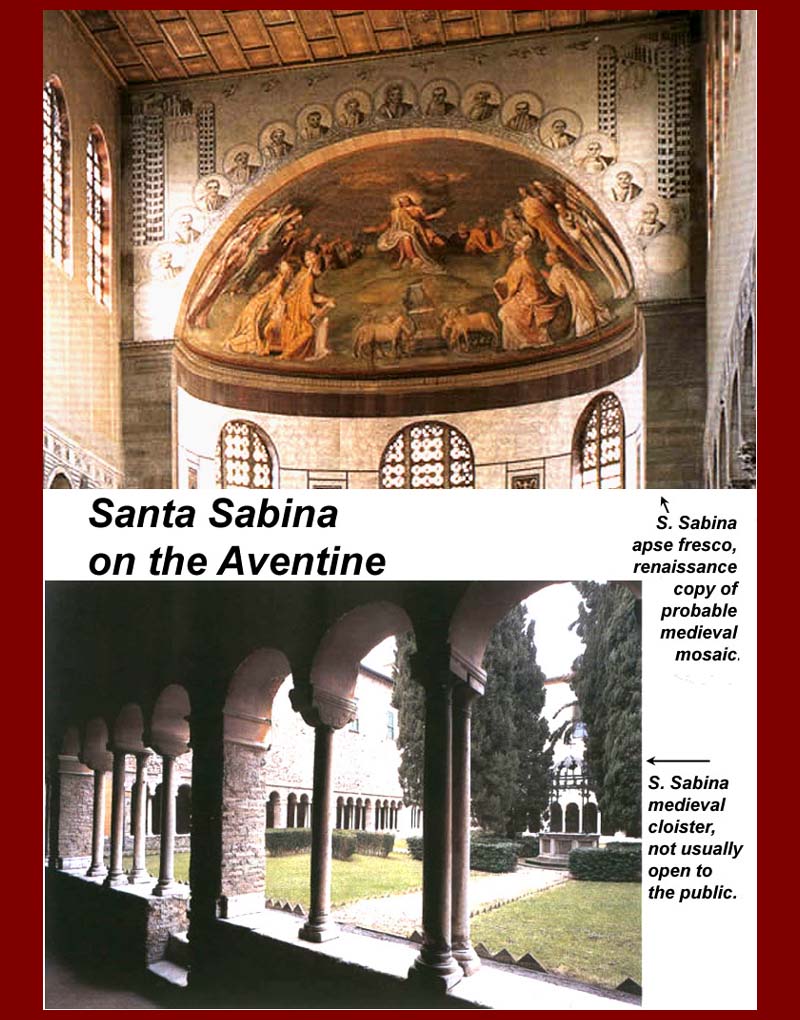
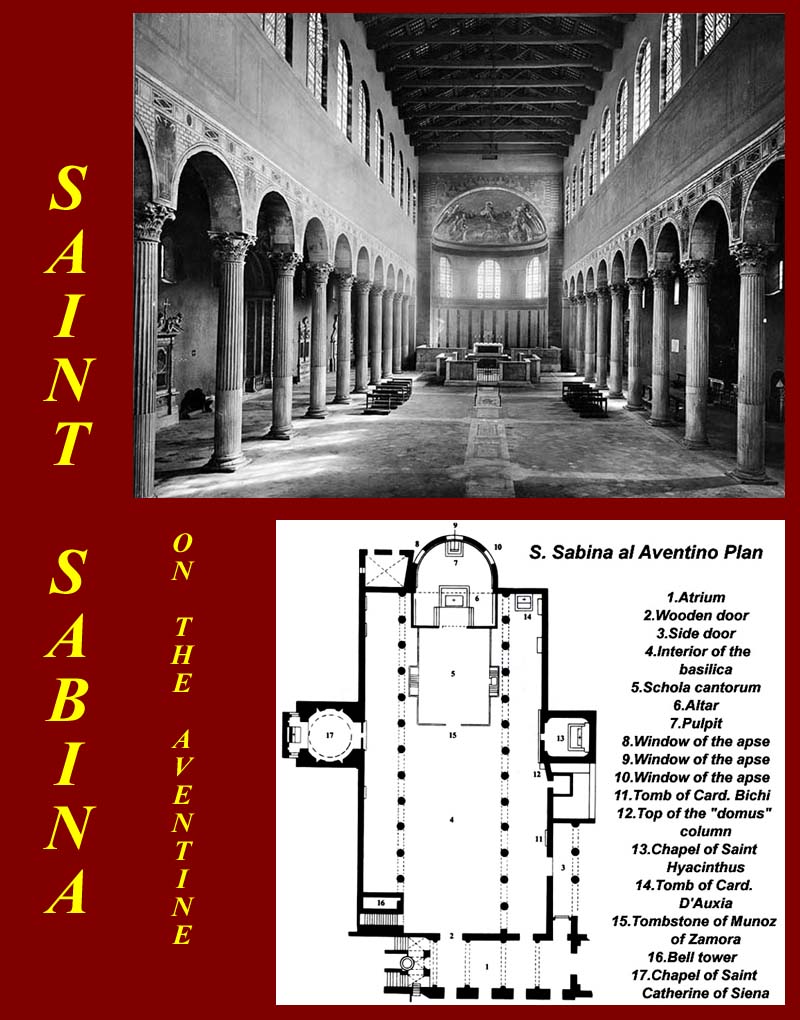
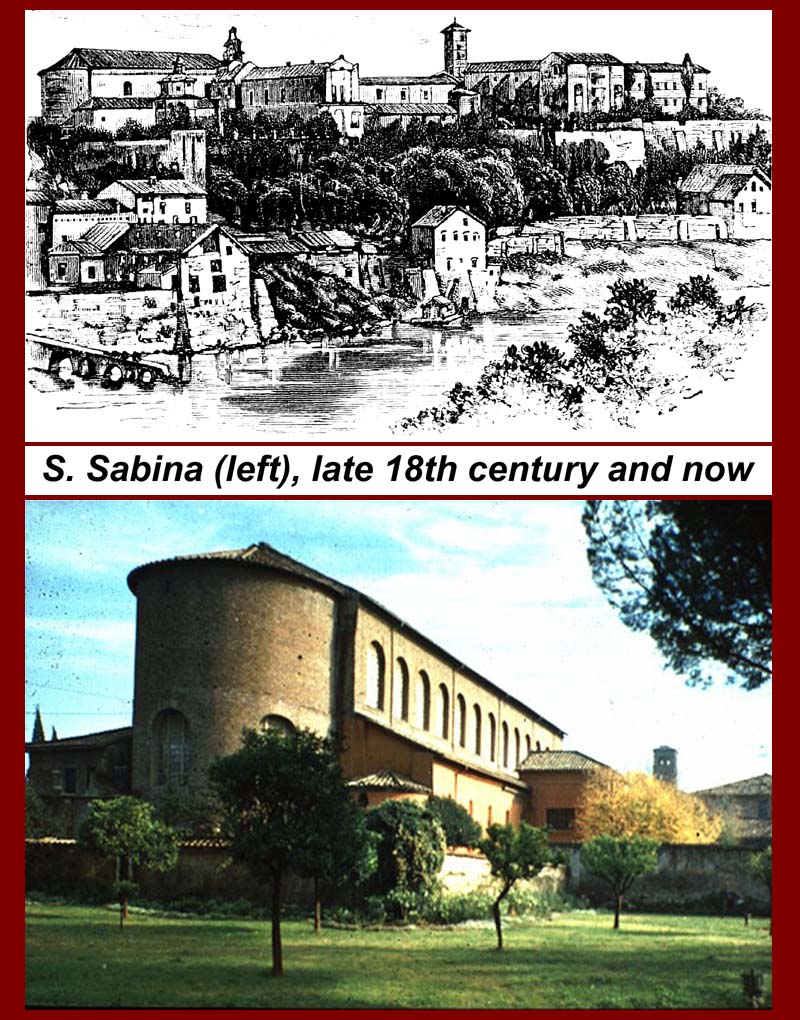
http://www.mmdtkw.org/MedRom0132-SSabApseCloister.jpg
http://www.mmdtkw.org/MedRom0133-SSabInteriorPlan.jpg
http://www.mmdtkw.org/MedRom0134-SSabExterior.jpg
http://www.mmdtkw.org/MedRom0135-SSabCrucifixDoor.jpg
S. Sabina on the Aventine Hill overlooking the Tiber is one of the few remaining essentially undisturbed/unchanged early medieval churches left in Rome. It is in the form of a classical basilica (nave with side aisles), high clerestory windows above the nave, and a hemi-circular apse at one end -- no transept. Above the apse is a 16th century renaissance copy (in fresco) of a 5th century AD medieval mosaic. The windows, which were designed to let light shine out from the church during evening services (and not, as is commonly thought of clerestory windows, to light the church interior during the daytime) are made of panels of the mineral selenite. The tall nave has 24 columns of Proconnesian marble with perfectly matched Corinthian columns and bases, which were spolia from the Temple of Juno Moneta, which had stood on the Capitoline Hill. A fifth century carved cypress-wood door contains 18 panels of narrative carvings. One of the panels is the oldest known depiction in the world of of the crucifixion of Christ. The marble schola cantorum, ambo and cathedra date from the 9th century and were reconstructed from fragments in the early 20th century. For more information of S. Sabina, see http://www.sacred-destinations.com/italy/rome-santa-sabina. The church was given to the newly formed Dominican order in 1222. Dominic and, later, Thomas Aquinas lived in the adjacent priory, and it was there that Aquinas began to write his Summa Theologica.
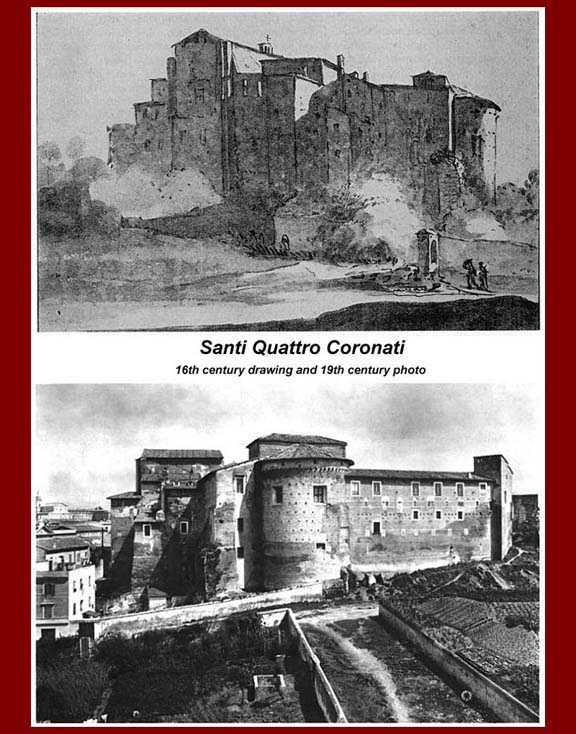
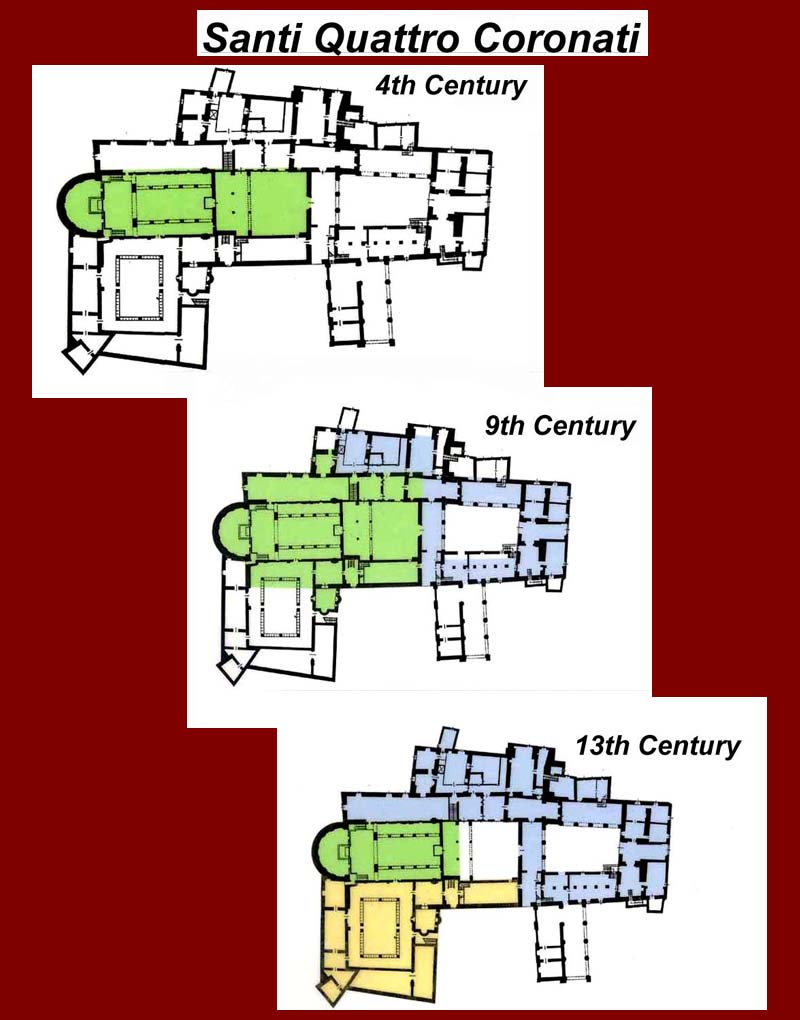
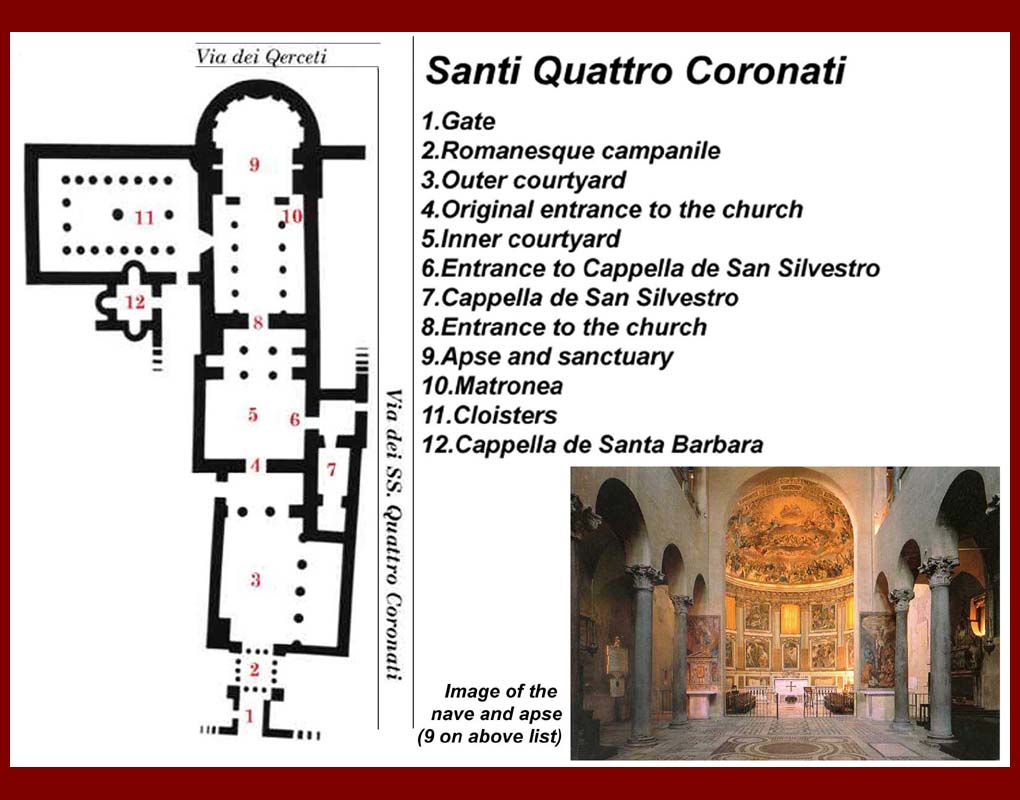
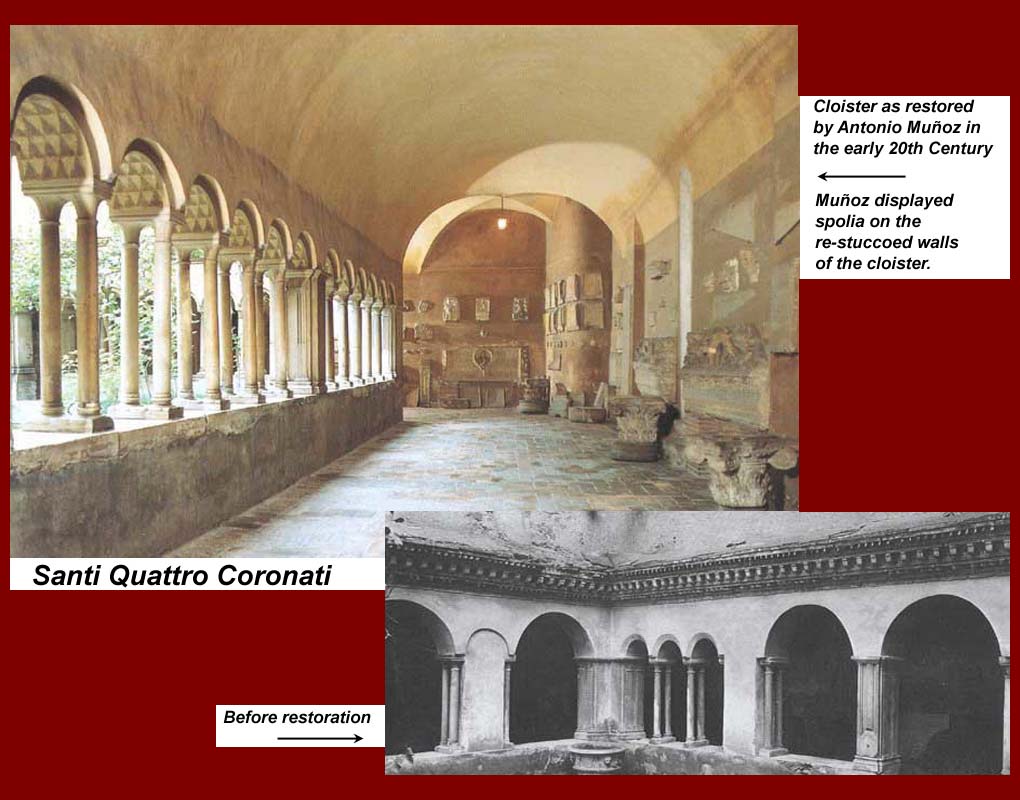
http://www.mmdtkw.org/MedRom0136-QuatCoron16C19C.jpg
http://www.mmdtkw.org/MedRom0137-QuatCoronExpan.jpg
http://www.mmdtkw.org/MedRom0138-QuatCoronatiInt.jpg
http://www.mmdtkw.org/MedRom0139-QuatCoroCloister.jpg
Note that the expansion of this church was not uninterrupted. A big section including the church's entrance, nave, and side aisles was destroyed when the Normans under Robert Guiscard sacked Rome in 1084. The basilica was rebuilt on its present smaller scale incorporating the old apse and triumphal arch. For more information on this church, go to http://www.santiquattrocoronati.org/index_enn.htm and http://romanchurches.wikia.com/wiki/Santi_Quattro_Coronati.
http://www.mmdtkw.org/MedRom0140-SilvesterChapel.jpg
One of the chapels on the Ss. Quattro Coronati compound is the Papal chapel dedicated to Pope Sylvester I. It is decorated with a fresco cycle from 1246 showing supposed incidents in the life of Sylvester. The paintings depict the untrue tradition that Constantine was baptized by Pope Sylvester and the fraudulent "Donation of Constantine" (shown), in which Constantine supposedly passed secular power from the Roman emperors to the popes and, not incidentally, justified the popes' supreme power over the Holy Roman Emperors -- Pope Innocent IV was contesting with Emperor Frederick II at the time the frescoes were painted..
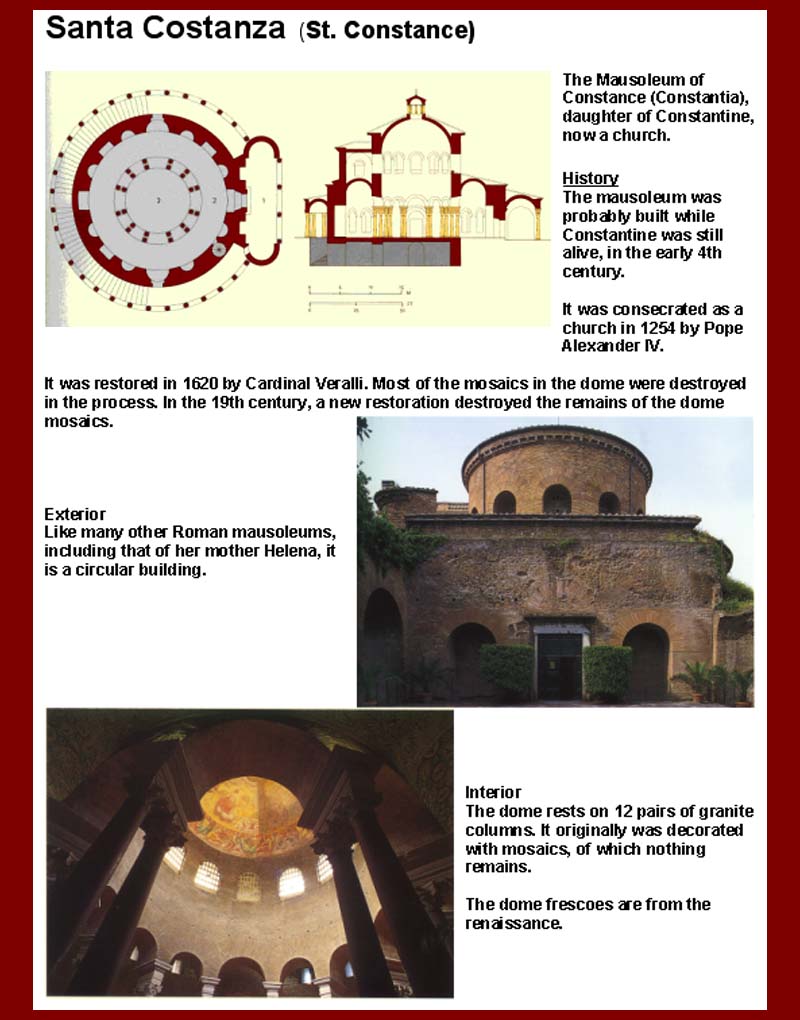
http://www.mmdtkw.org/MedRom0141-SCostanzaRound.jpg
http://www.mmdtkw.org/MedRom0142SCostanzaMosaic.jpg
The church of S. Constanza is the converted tomb that Constantine commissioned for his daughter. Although the ancient mosaics in the dome were destroyed in 17th and 19th century "restorations", fine 4th and 5th century mosaics are preserved in the nave and in wall recesses. The church also houses a porphyry replica of Constanza's sarcophagus (original in the Vatican museums). [Note: the word sarcophagus is derived from two Greek root words, sarx (genitive of sarkos ) = "flesh" + phagein = "to eat": a kind of limestone quarried near Assos in Troas, Turkey (i.e., the area around Troy), was used to make burial boxes because it was thought to speed decomposition = eat flesh.]
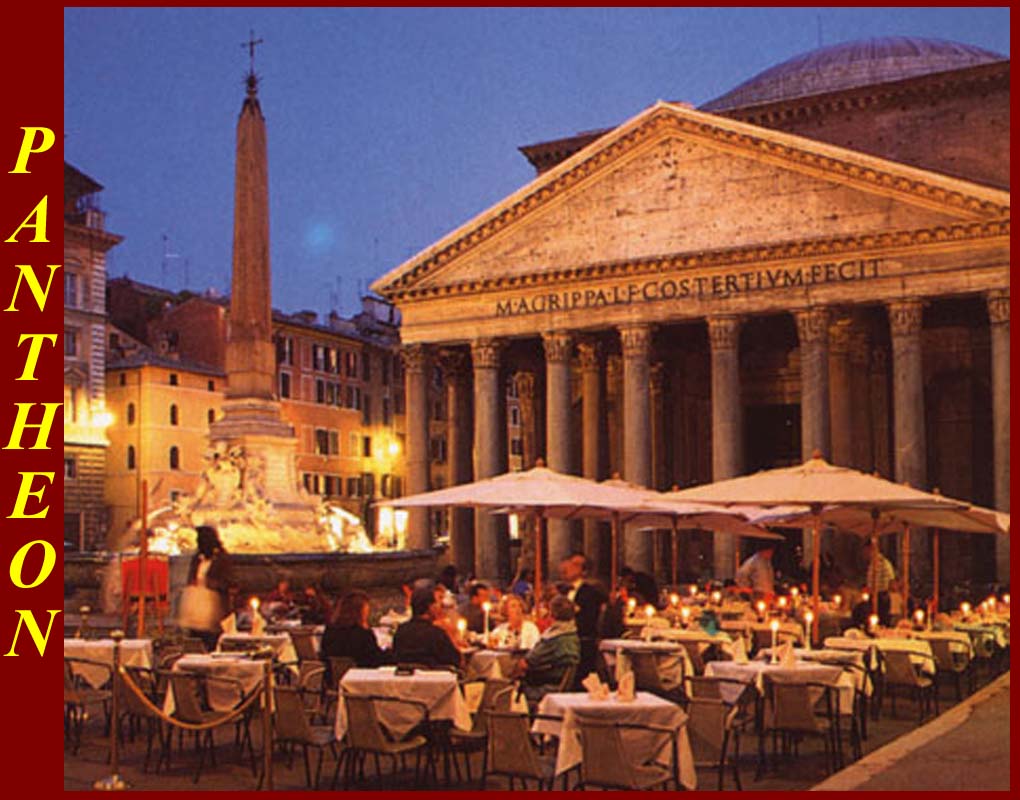
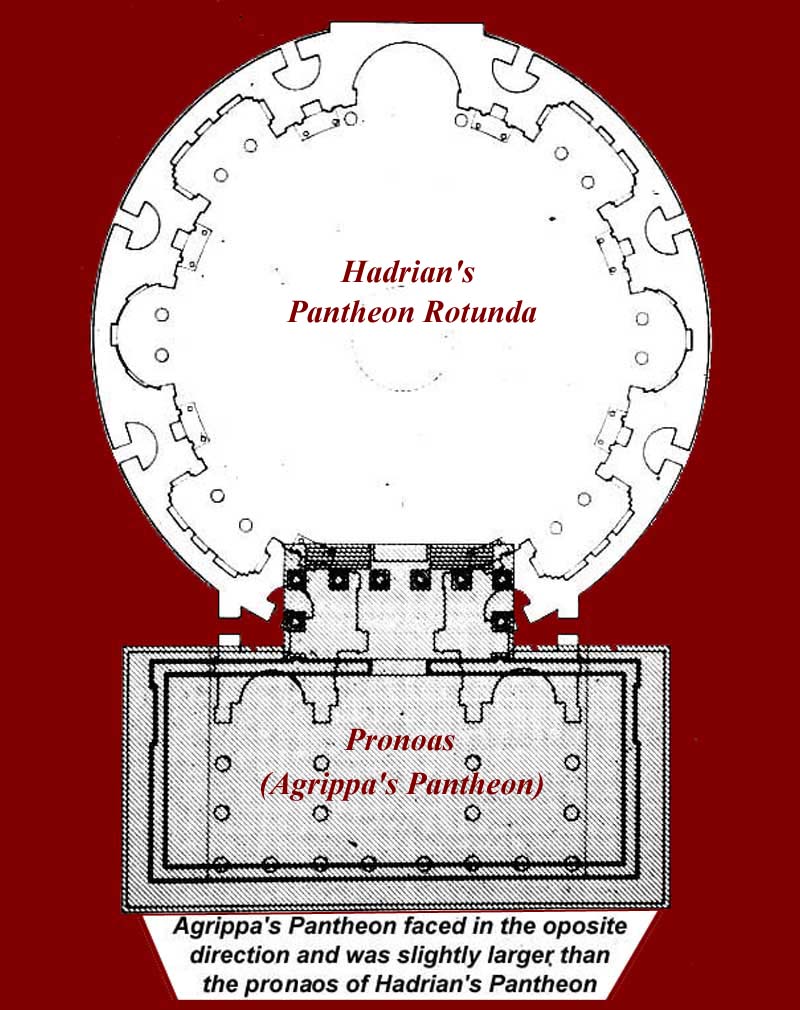
http://www.mmdtkw.org/MedRom0143-Pantheon.jpg
http://www.mmdtkw.org/MedRom0144-PantheonsPlans.jpg
http://www.mmdtkw.org/MedRom0145-PantheonDuPerac.jpg
S. Maria ad Martyres church, the centerpiece of Rome's Campo Marzio, is the converted Pantheon of Hadrian. The inscription over the pronaos (the front porch) says that it was built by Marcus Agrippa, the right hand man of Augustus, but that inscription really applies to the smaller earlier Pantheon that stood on the site of the pronaos. It is often but incorrectly said that the Pantheon is the only structure from ancient Rome that has been in continuous use. Actually, it was closed in the 5th century, but in 608/9 Emperor Phocas gave it to Pope Boniface IV so that it could be turned into a church. It also was not in used during part of the the period when the Popes decamped to Avignon (1309-1377). For more information on the church, see http://www.sacred-destinations.com/italy/rome-pantheon and http://romanchurches.wikia.com/wiki/Santa_Maria_ad_Martyres.
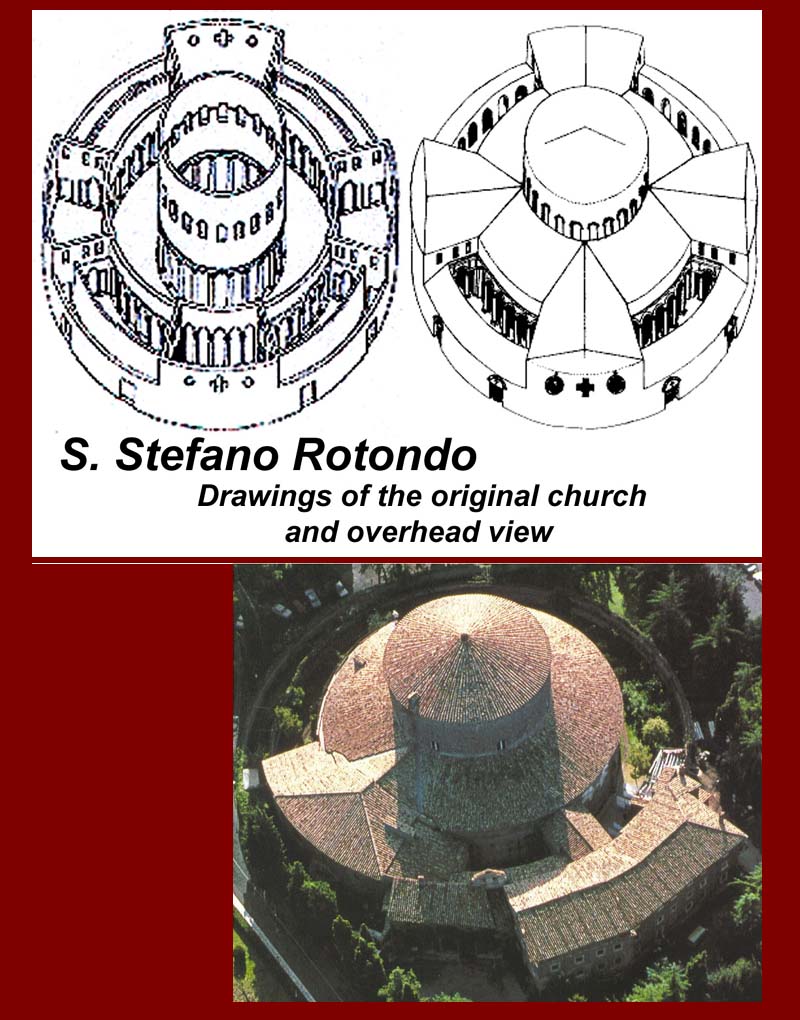
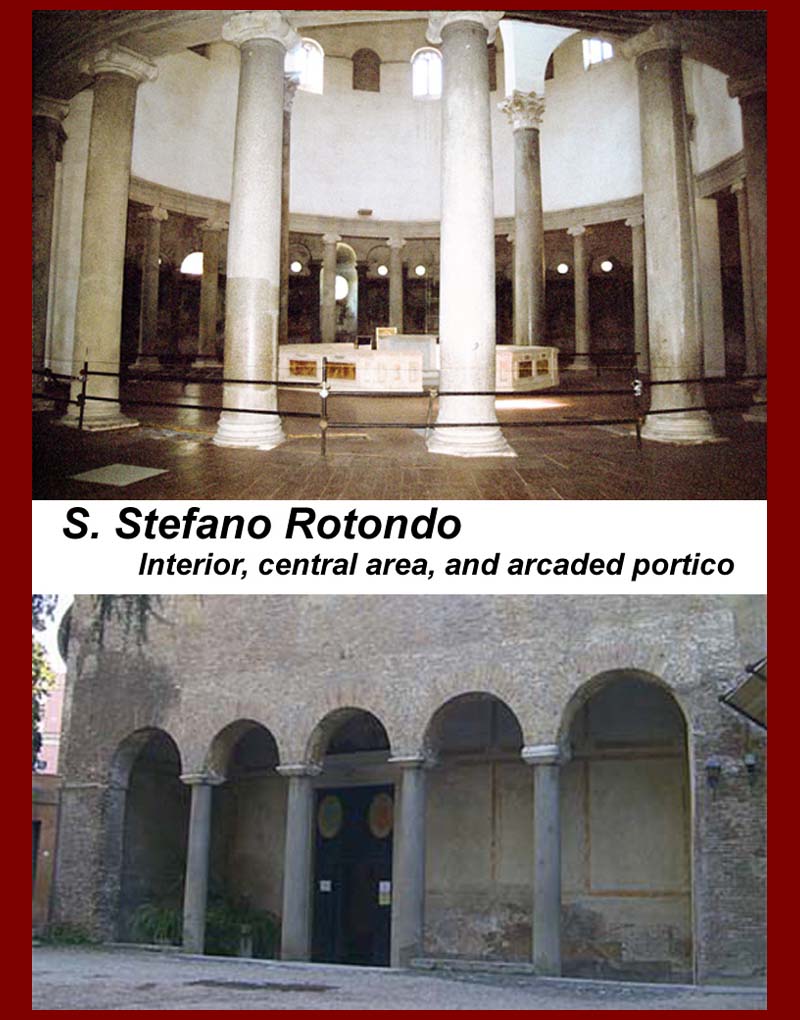
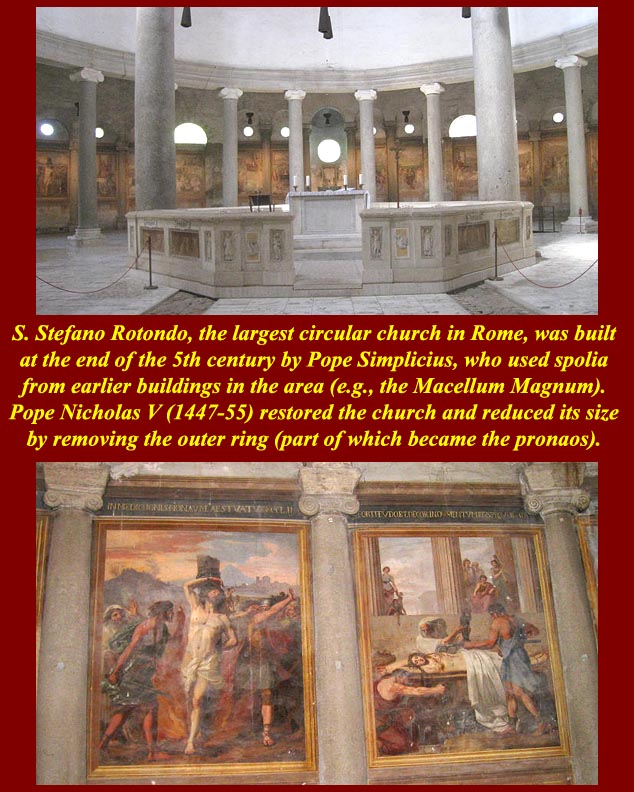
http://www.mmdtkw.org/MedRom0146-SStefanoRotondo.jpg
http://www.mmdtkw.org/MedRom0147-StefanoIntPortic.jpg
http://www.mmdtkw.org/MedRom0149-StefanoRotondoInterior.jpg
http://www.mmdtkw.org/MedRom0148-HolySepulchre.jpg
S. Stefano Rotondo on Rome's Caelian hill is the largest circular church in Rome. The core of the church was built to house the relics of the protomartyr St. Stephen in the reign of Pope Simplicius (468‑483) on the site of a 2nd or 3rd century AD Mithraeum, the remains of which were found in 1973. It almost certainly follows a Byzantine model, maybe that of the Church of the Holy Sepulchre (the plan of which is shown) in Jerusalem. It is usually said that it is the oldest remaining example of a round church. It was originally built in the form of a Greek cross and three concentric circles of columns, superimposed: an architectural rendition of the cruciform nimbus (= halo) of Christ; or, alternately, a tangible translation of "the triune God, crucified". The Corinthian column capitals reinforce this theme: not reused from a pagan building, but specially made, with crosses part of the design. The outer ring of columns was demolished in 1450 (or 1453, depending on the source) by order of Pope Nicholas V, as were three of the arms of the Greek cross.
St. Stephen was the Christian faith's first martyr; in keeping with this, Gregory XIII (1572‑1585) had a cycle of 34 gruesome frescoes of the Tortures of Martyrs painted by Pomarancio and Antonio Tempesta. Some of these late Mannerist paintings were in turn reworked in the 19th century; they are not the church's most attractive feature. The floor of the church, which was damaged during the excavations of the Mithraeum, and the torture paintings have recently been restored.
Under the church there is a 2nd century Mithraeum, related to the presence of the barracks of Roman soldiers in the neighborhood. The cult of Mithras was especially popular among soldiers. The remains of Castra Peregrinorum, the barracks of the peregrini, officials detached for special service to the capital from the provincial armies, were found right under Santo Stefano Rotondo. The Mithraeum belonged to Castra Peregrinorum, but it was probably also attended by the soldiers of Cohors V Vigilum (5th district police and fire departments), whose barracks stood nearby on the other side of Via della Navicella.
The Mithraeum is currently being excavated. The remains of the Roman military barracks (from the Severan Age) and the Mithraeum under the church remain closed to the public. A colored marble bas-relief, "Mithras slaying the bull" from the 3rd century is today in Museo Nazionale Romano.
For more information about this church, see http://en.wikipedia.org/wiki/Santo_Stefano_Rotondo.

